4. THE KUMSA FUNERAL CELEBRATION
Descriptions, fieldnotes and quotes from written sources
4.1 Preliminary remarks on the funeral celebrations
4.1.1 Terminological and methodological considerations
The first part of this study generally incorporated quotations from my field notes into a textual presentation or added to the final part of a chapter (‘Further information’); by contrast, in this section, the information about two major Bulsa funerary celebrations (Kumsa and Juka) had to be presented in a slightly different manner. Here, the field notes constitute the actual chronological framework for the funerary celebrations. Analyses and summaries are then provided as individual essays in the Appendix. Nevertheless, an attempt to organise the rites of the Bulsa funerary celebrations of various villages in chronological order is inevitably fraught with great difficulties, including:
1. Many rites (e.g. imitation, rattling at the mat, processions around the compound) accompany almost the entire funeral celebration or at least extend over several days.
2. Many rites take place almost independently of each other or in parallel.
3. There are differences in how individual villages and sections perform rites; some rites only occur in certain clan sections.
4. The chronological sequence of the rites is not wholly fixed but is discussed and determined by the old men in the kusung dok before the celebration begins. They also decide whether, for example, a day of rest will be included and whether some rites will be omitted or performed in another context of the ritual structure.
Considering these confounding factors, the list of notes presented in this section can only sketch a rough indication of what rites and other activities can be expected on a particular day and at a particular time. Their numbering has been added primarily for ease of reference.
Names: In this work, the first celebration of the dead is referred to as Kumsa (pl.), which accords with the common usage of many informants.
Azognab (2020) uses the Buli term kuub-kumsa. On this term, E. Atuick (2020: 37f.) writes: ‘…the kuub-kosik (the dry funeral) … involves the performance [Kumsa] of the funeral [kuub]… He calls the first funeral celebration “kuub-kumka.”’
In Ghana, the English term ‘dry funeral’ is used for a funeral celebration, in contrast to ‘fresh funeral’, which refers to the burial immediately after death. The word ‘funeral’ without an attribute usually only refers to the two funeral celebrations.
R. Asekabta (by letter): ‘I think kuub-kumka means the art of performing a funeral or how to perform a funeral and Kumsa is a short form of performing a funeral, for example ([as in] “kuumu kumsa ale chum”, [meaning] the performance of the funeral will be tomorrow)’.
F. Kröger, referring to the Buli-English Dictionary, offers the following definitions: Kumsa is a plural noun meaning (1) ‘mourning’, ‘weeping’, ‘crying’ or (2) ‘funeral’ or ‘the performance of a funeral’; kuub is a noun (plural: kumsa, kuuna) meaning ‘death case’ or ‘funeral celebration’.
Funerals attended by the author (and his assistants)
Kumsa funerals (or parts of them) were attended (unless otherwise noted) in the following compounds and time frames:
Atekoba Yeri, Sandema-Choabisa (fn 73,60–65) on 17–18 April 1973: the funeral celebration of a blacksmith who died at the advanced age of about 90 in March 1973 (he was said to have ‘still been fighting Babatu’). I only visited on the tika dai.
Asebkame Yeri, Wiaga-Chiok (fn 88,119a–121a) in December of 1988: held for a man, a married woman and two children. Only the gbanta dai was attended on 6 December 1988.
Wiaga-Sichaasa (fn 88,185) in 1989: the funeral of an old man and an old woman; a short visit was paid on 19 January 1989 (tika dai).
Akadem Yeri (fn 88,197+200a+b), Wiaga-Yisobsa in 1989: for almost a dozen men and women, visits on 28.January1989 (tika dai) and 31 January 1989 (gbanta dai).
Acha Yeri, Sandema-Chariba (fn 88,221b+222a) in 1989: Kumsa for a deceased married woman; a visit was paid on 5 March 1989 (gbanta).
Awuliimba Yeri, Sandema-Kalijiisa-Anuryeri (fn 88,223–226) in 1989: Awuliimba was the father of James Agalic, the assistant and informant of R. Schott and F. Kröger; visits were paid on all days (7–10 March 89)
Abanarimi Yeri, Wiaga-Chiok-Ayaribisa (fn 233a+b) in 1989: rituals for two married women (rites behind the compound), a returned daughter (in front of the compound) and a boy; visit paid on gbanta dai (16 March 1989)
Abapik Yeri, Wiaga-Badomsa (fn 88,305b) on 5 September 1990: Detailed information and photos were provided by Danlardy Leander.
Anyenangdu Yeri, Wiaga-Badomsa on 3–6 March 1991: the funeral celebration for Anyenangdu, the father of my main informant Anamogsi (photos and information were provided by my German friend and colleague, M. Striewisch as well as by Danlardy Leander). I also received detailed information and explanations from Anamogsi and other compound residents. Although I could not attend this funeral celebration in Anyenangdu Yeri, my residential compound, between 1978 and 2011, I received the most detailed material available for it among all funerals and could discuss all disputed questions until 2011.
Agbain Yeri, Wiaga-Yisobsa (fn 01,3a+b) in 2001: the visit – on the tika dai – occurred on 13 February 2001, and the gbanta dai took place over two days on 15 and 16 February 2001.
Atinang Yeri, Wiaga-Badomsa (fn 06, 6a+b; 10a, 27 January 2006): I could not attend the Kumsa in mid-March of 2005, but Anamogsi, Danlardy, and Yaw provided good information. It was held for deceased people from Atinang Yeri: Atinang, Angmarisi (Atinang’s younger brother), and Kweku (a young man). The following persons from Anyenangdu Yeri were included: Awenbiisi (Anamogsi’s son), Akansang (Asuebisa’s son), Agoalie (Anamogsi’s wife), and Adiki (Azuma’s young daughter). The imitator of Atinang was Atakabalie (Anyik’s wife); the name of Angmarisi’s imitator was forgotten by my informants. Ajadoklie imitated Agoalie. Per information provided in a supplementary letter from Danlardy (May 2004), when Agoalie died in her parents’ house, she was buried there, and a funeral celebration was held. Later, a second funeral was held in Anyenangdu Yeri.
Danlardy, in a letter dated 7 May 2004 (fn 2002,3,55a*), wrote that women’s funerals could be held twice.
Agaab Yeri, Wiaga-Yisobsa-Chantiinsa (fn 08,15) for two male and five female deceased people; visitation occurred on 17 February 2008 (kalika); 21 February 2008 was the gbanta dai.
Adiita Yeri, Wiaga-Yisobsa-Guuta in February 2008: The kalika took place on 22 February and the gbanta occurred on 24 February 2008 (the tika dai was cancelled). I (F.K.] could document only one late phase of the gbanta myself.
Ataamkali Yeri, Wiaga-Longsa on 25–29 January 2011: compound of the kambonnaab and earth-priest Afelik (the tika dai, kpaata dai, and gbanta dai were observed).
4.1.2 The soul (chiik) of the dead
The following text was adopted in an abridged form from F. Kröger’s ‘Religious and rebellious elements in Bulsa funeral rituals’, an article published in BULUK’s 10th volume (2017), pp. 97–99.
Although the Bulsa are often regarded as one of the best-studied ethnic groups in Northern Ghana, their funeral rituals – with their unique interweaving of countless religious rites and various secular acts – have never been the subject of a general monographic publication.
The basic religious idea of funeral celebrations may lie in preparing the transition of the deceased from the land of the living to that of the dead. In better understanding this process, it is necessary to clarify which parts of the human personality are affected by certain rites concerning the deceased. The Bulsa attribute multiple personality components to each person.
One of them is nyuvuri (cf. nyueri, ‘nose’, and ‘vuum’ life) or the ‘pulsating life’, which is mainly revealed in the respiratory movements. Another component is the ‘life force’ or pagrim, which is demonstrated in physical strength and immunity from and resistance against harmful spiritual influences, including ghosts, witches, and bush spirits (cf. Kröger 1978: 143–145). The personality components mentioned so far play a subordinate role in burial and funeral rituals. More important are the functions and activities of the following three components (ibid. 140–143):
(1) the body (nying, pl. nyingsa)
(2) the wen, a divine power associated with an individual, but worshipped by sacrifices to a shrine outside the body (Kröger 1982: 6ff, 2003: 254ff)
(3) the soul (chiik, pl. chiisa)
The dead body and its odour (piisim) may be a great danger to the living – only the initiated gravediggers know the correct way to deal with them. The corpse of a deceased person is usually buried on the day of death. This activity occurs within the narrow circle of one’s family (cf. 3.4 and 3.5).
The veneration of a deceased person’s wen often intensifies only years after the burial. Although the wen-shrines of the deceased exist in the compound during the funeral celebration, sacrifices to these or any other rituals concerning them are not a part of the celebration.
Among the religious events of the first funeral celebration, the rituals concerning the soul (chiik) of the dead are paramount, as explained below. After the burial, the soul of a dead man is represented less by the grave than by the sleeping mat (called tiak; rolled, it is called ta-pili) on which the dead man died – it is regarded as the abode of his soul. In the past and even in some present compounds, this representation of the dead in the ta-pili entailed leaving a small dish of food in the ancestral room every evening and removing the untouched food the next morning. The food is left behind because the dead man did not consume it in a material sense, only taking its power or substance as nourishment. Afterwards, this food can be consumed by humans or fed to animals. In addition, known preferences of the deceased, such as his enjoyment of beer, kola nuts, or tobacco, are respected by placing these luxuries in the ancestral room for some time.
The soul of the dead is not always enclosed in the mat or hovering around it. It can, for example, visit the deceased’s body in the grave (boosuk). A small hole is left in the ceramic cover of the grave, so the soul can have free access until the end of the final funeral (Juka).
Information about the soul
According to information from Gbedema, some Bulsa (usually thoughtlessly) invite the ancestors or the dead to eat with them by uttering the following sentence before eating saying ‘Ni de abe ni ge te mu’ (‘You eat before you give me’). Moreover, a ceramic pot (liik) with drinking water – placed in one corner of each courtyard – should never be empty so that recently deceased persons and ancestors can serve themselves there.
When the head of a compound (yeri-nyono) dies, either his eldest brother or his eldest son performs all important rituals and is responsible for the deceased’s soul. However, he must inform his predecessor about every important ritual in the compound by speaking to the deceased’s soul, which resides in the mat (see photos).

The acting head of the compound, Leander Amoak, informs his ancestor Abonwari about a ritual event.
Godfrey Achaw (fn 73,178): A soul can be strong (powerful) or weak. A person with a strong soul is difficult to kill or harm.
The soul can leave the body at night and revisit all the places it has visited during the day (and others). If a ghost haunts the soul at night, the sleeping person will dream about it. After death, the soul of a witch becomes a ghost (kok). Other people’s souls go to Naawen (God) after death or, as others say, to Ajiroa, the realm of the dead. When I [Godfrey] die, I [will be] reborn with my body in Ajiroa, but strangers [will not be able to] see me. At the same time, my body remains present in the grave. The food that family members place in the room where the mat is located is intended for the chiik of the deceased. Anyone can eat the food later except for the spouses of the deceased.
Apusik (Sandema-Kobdem? fn 88,126b): The soul of the deceased moves to the realm of the dead, Ajiroa, after the Juka celebration. Others say that the soul continues to dwell in the bui (granary) of the deceased person. When the soul visits its old compound from Ajiroa, it will live in the bui. The [round] stone (tintankori) on the [bui’s] floor also symbolises the soul.
Danlardy says in his examination paper (fn 86,12a): Every person (nurbiik) has three souls (chiisa): (1) one goes to God after death; (2) one lives on in the dead body; (3) the sitana soul is annihilated at death, i.e., it dies with the soul. The third soul tempts the living person to do evil.
Margaret Arnheim (fn M79,8b): She herself was afraid of cows. She had a dream that she was being chased by cows. The neighbours told her that witches were haunting her soul.
Azognab 2020: 56: The fourth interview question to the [15] respondents was, ‘What happens to the human person after death?’ All the respondents answered that the chiik (soul) of the person hovers around the ta-pili (death mat), the boosuk (grave), and the dalong or kpilima dok… until the death and funeral rites and rituals are properly completed.
4.1.3 General information on the funeral celebrations
(See also 7.1.–7.5 and F. Kröger 2017: 97–113: Religious and rebellious elements in Bulsa funeral rituals)
4.1.3.1 Abolition of taboos (kisita, sing. kisuk) of everyday life
Godfrey Achaw (fn 73,32): If adultery occurs during a festival, it is not considered adultery, and a wife need not inform her husband. Another cancelled taboo during major festivals is that a Kalijiisa man can marry a Kobdem woman (however, marriage within a section is not allowed). This lifting of taboos is limited to (1) the funeral of a great old man, (2) the Fiok harvest festival (November–December), and (3), in some instances, sacrifices to the land.
Apusik, Sandema (fn 88,226b): At a funeral, the following taboos are lifted:
1. Suma (round beans) and tue (small beans) are cooked together in one pot
2. Cloth or clothing may be placed on the roof of the kusung or kusung dok (otherwise, this placement is forbidden)
3. Certain songs may only be sung at funeral celebrations
4. One may stop at the main entrance for a while (nansiung)
5. Otherwise, you are not allowed to mourn inside or outside the cattle yard (?)
6. Sexual permissiveness exists only on the kpaata dai
Yaw (fn 06,34b): At funerals, the following taboos are abolished: (1) one may sing funeral songs; (2) rolled-up mats are placed with their tops to the ground; (3) usually, one may not walk over lying mats – if this happens, you must jump back and walk around the mat; if an animal steps over the mat, it is killed immediately – but they can be walked over during funerals; (4) sex outside the compound is permitted but is otherwise strictly taboo; (5) cooking suma and tue beans in one pot is permitted but is otherwise taboo.
Yaw has never heard of a cancellation of the exogamy or incest commandment. Standing at the entrance is also forbidden at funerals, according to him, but according to other information, it is permitted.
(Yaw, fn 01,2b): Imitation at a worldly festival (tigi) is taboo (kisuk).
Yaw: Blowing the kantain horn trumpets is only permitted during funerals.
Danlardy, Yaw, et al. (fn 94,22a): The eldest son of a deceased person may not wear that person’s clothing during his lifetime. At the Kumsa, he dresses in these clothes before the impersonator puts them on.
U. Blanc (2000: 55, 136f and 145): The intonation of the rhythms during zong zuk cheka (playing music on the flat roof) is taboo outside the funeral celebration (kisuk).
4.1.3.2 Further general brief information on the Kumsa funeral celebration
Funerals for women
F.K.: Funerals for married women are typically held in their husband’s compound together with those for deceased men.
If a funeral celebration is held for women only, some acts, such as the war dances, are omitted altogether. Furthermore, if the burning of the mats is postponed to the first day, the entire second day is cancelled (this is also confirmed by Aduedem).
Timing of the celebrations
Godfrey Achaw (fn 73,47): The first funeral celebration occurs in the next dry season or years later.
(fn 73,54b): The timing of funerals among the ko-bisa in Sandema-Yongsa must be precisely coordinated. If one compound is ready to perform a funeral, it must wait for its turn. However, after 20–30 years, the four houses of the ko-bisa of Achaw Yeri will probably become completely independent (without any obligation to wait).
Yaw (fn 01,2b): Unlike in Sandema, funerals in Wiaga are not allowed to start on a market day. In Sandema, many individual rites or other acts are omitted on market days.
Aduedem 2019: 12f: On average, the [Kumsa] takes three or four days for the male or female [deceased people], respectively, or four or five days for an elderly man or woman of status, respectively. The timing of when final funeral rites of mixed sexes are celebrated together depends on the part of Buluk; in Chuchuliga and some other parts, male funerals take precedence, whereas, in Sandema and the southern part of Buluk, female funerals take precedence. Thus, the days [proceed] according to whose funeral takes precedence in cases of mixed celebrations.
Funerals that are mistakenly held for living persons
Akambonnaba, Cape Coast (fn 73,53a): If someone’s funeral was held, he is presumed dead. Akambonnaba’s father had to drive an ambulance during the war. When his home compound in Siniensi received the news that their father had died in the war, a funeral was held for him. Although this father reappeared, he was presumed dead and was never allowed to reappear in Siniensi (though his children were).
Godfrey Achaw (fn 73,53a): Godfrey also knows of a case where a funeral celebration was held for a man from Sandema who had gone missing and was supposed to be dead. After his return to the Bulsa area, he was no longer allowed to go to Sandema. When he passed there in a car, he pulled a scarf over his head. He was neither allowed to accept gifts from Sandema or give gifts there. People from Sandema were allowed to visit him outside Sandema.
Margaret Arnheim, Gbedema (fn M20b): During the war, funerals of living people were held by mistake. When they returned, they were accepted back into the community. It is said that they will have a very long life.
Miiga funerals
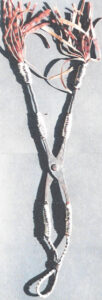
Ritual miiga from Wiaga-Chiok
Leander Amoak and a blacksmith (Ako?) from Wiaga-Chiok (fn 73,151):
For very important men of the blacksmith section, part of their funeral celebration is held while they are still alive. A pair of blacksmith’s tongs (miiga) that are transformed into a fly whisk with leather fringes plays an essential role in this. The whisk is used to drive away evil spirits. Several cows are sacrificed at a miiga funeral but not, as elsewhere, on the ash heap (tampoi). If the person later dies, no further animals are sacrificed. A few weeks ago, a very sick man was honoured with such a miiga funeral but died shortly afterwards. Leander had never heard of a miiga funeral. A miiga was made for me (F.K., see photo), which is now in the Völkerkundemuseum Werl.
Thomas Achaab from Sandema-Choabisa (fn 73,151b): The miiga also plays a major role in Sandema-Choabisa when a great old man dies. On the day of death, the miiga is decorated with leather strips, and an iron rod is carried around the house.
The deceased person and his funeral celebration
Godfrey Achaw (fn 73,55a): If a man dies very suddenly (e.g., through a tanggbain), he does not receive a funeral celebration. His death mat is burnt on the day of his death, and rarely, he is also buried as an adult man outside the compound. Women who die in childbed are usually given a funeral celebration. Deceased infants up to about three years of age and with no younger siblings do not receive a funeral celebration.
Yaw (fn 97,39b) The funeral celebrations of earth priests and smiths are completely similar to those of other persons.
Yaw (fn 23b): Women who have never had children (a daughter by another man would here count as a child) receive the funeral celebration of a man.
Further prescriptions and prohibitions
(See also 4.1.3.1: Lifting of taboos of everyday life at death celebrations)
Godfrey Achaw Kalijiisa-Yongsa (fn 73,48a): During the three (for male dead) or four days (for females) of a funeral, all women sleep in the compound, and all the men sleep outside.
(fn 73,69): Godfrey and his friend, John, who is from the neighbouring compound and belongs to Kalijiisa Chariba, were born on the same day. If there is a funeral celebration at John’s house, John must sleep and eat at Godfrey’s compound (Achaw Yeri) until the celebration ends, even if Godfrey is not present. John can attend all the events of the celebration from there.
F.K. observation (fn 94,11a): When I visited Rita Atuick to observe her making soap, her brother – the new chief of Wiaga – was lying in the kusung of her house. He was not allowed to enter the chief’s compound during the four days of his predecessor Asiuk’s funeral celebration.
Conflicts and harms
Danlardy Leander (fn 88.1): After Leander’s and before Adiak’s death, there was much quarrelling between Leander’s children and Adiak. Adiak urged Danlardy to hold the funeral celebration of Abonwari (who died probably in the nineteenth century), as this would have made him the kpagi of the Ayarik-bisa. When Adiak’s wife died, Danlardy wanted to combine her funeral with that of Abonwari, Atiim, and Leander. However, Adiak held his wife’s funeral without the others.
Ayarik Kisito (fn 73,319b): A harmful charm (jugi, pl. juga) is only used at funeral celebrations. This jugi is a black powder of crushed medical charcoal that is sprinkled on the ground. Anyone who steps on the charm catches elephantiasis.
Musical instruments
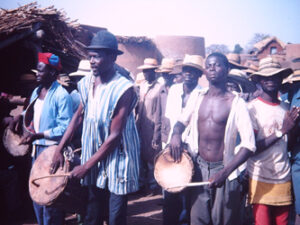
Music group at Anyenangdu’s Kumsa celebration
Leander Amoak (fn 81,30): The following instruments are played at funeral celebrations: [F.K. at processions around the house?]: six flutes (wiisa), two cylindrical drums (ginggana), two calabash drums (goa), one hourglass drum (gunggong), and one pair of sinyaara rattles.
For war dances, musicians play one dunduning drum, one double bell (sinleng), and one kantain horn trumpet (similar to the namuning horn trumpet).
For fun and dancing, one calabash drum (gori) and one pair of sinyaara (wickerwork rattles or round calabash rattles) are played.
Further information
Godfrey Achaw (fn 73,60a): The funeral celebration of Atekoba (Choabisa) on 17 April 1973 was organised by the head [kpagi] of Choabisa, whose eldest son had to pay for the costs. Atekoba was buried in a residential courtyard [F.K.: ma-dok?] of his compound. At 11 p.m. before the first day, it started to rain (which was a good sign). It was believed that Atekoba had caused the rain. Men climbed onto flat roofs and performed war dances without helmets and with an axe. Such dances are also performed when rain starts after a long time of dryness.
Margaret Arnheim (fn M52b): Margaret went to the funeral celebration in a completely different section in Siniensi (with Mary Assibi, who was distantly related to the concerned compound) because there was a large ‘packed funeral’ there – the funeral celebrations of many people were combined into one. The phrase used was ‘Ba tigsi kunanga ngomsi’ (‘They “pack”/“collect” funerals’).
(fn M,61a): If only the Kumsa celebration but not the Ngomsika (Juka) celebration is performed, one says ‘nye kuub zaani’ (‘to perform half of a celebration’).
4.1.4 Preparations and planning for the first funeral celebration
Before the funeral celebration, the costs for animal sacrifices and other expenditures are calculated, and planned invitations are discussed thoroughly.
4.1.4.1 Planned invitations and cost breakdowns for Asik Yeri, Badomsa (see genealogy in Appendix 2)
New plans for timing and cost continue to be made for the outstanding funeral celebrations for the dead (including Abonwari, who died in the nineteenth century). To my knowledge (F.K.), they have not yet been realised to date (2023).
Danlardy Leander (fn 86,7a): The pending funeral celebrations in Asik Yeri will probably be held in two sections: first, the older generation (Abonwari) and then the younger generation (Atiim and Leander). Adiak urged Danlardy to perform the funeral celebrations and insulted him. Based on this, I (F.K.) should not visit him again from now on.
Danlardy Leander (fn 2002/3,55a*): Regarding plans for Leander’s funeral, Asik Yeri will be renovated beforehand, and official invitations will be sent to the families of Ayarik-bisa, Adum Yeri, and Aluechari. The funeral will be combined with those of Abonwari, Akanzaaleba, Atiim Maami, Atoalinpok and Aparing. It will be organised by Michael Atiim (a nurse), Danlardy, and the younger siblings. They also provide money for the nang-foba animals, cheri sacrifices, and millet porridge (saab), as well as rice to feed the guests and malt (kpaam) for millet beer.
Invitations and costs for the planned funeral celebrations in Asik Yeri
Danlardy Leander, (fn 06,5a) 24.1.2006: A preparatory meeting was held in Asik Yeri on 7 January 2006. The following ‘uncles’ and ‘aunts’ (i.e., matrilineal relatives), or representatives of their lineages were to be invited to the planned funeral celebrations (of Leander et al.) (see genealogy in Appendix 2):
1. Wabilinsa: Awon Yeri
2. Dokbilinsa: Achambe (Achagbe?) Amoak
3. The Gbedema chief’s house: Akan-nyemi
4. Bilinsa: Akpadiak
5. Longsa: Ajaana
6. Chiok: Assibi
7. Kadema (Atongka’s relatives)
8. Abavare (Atongka’s relatives in Chiok)
The following funerals were obligatory to be attended beforehand (including those of matrilineal uncles and aunts):
1. Abonwari’s wife’s funeral in Gbedema was to be attended by 2–3 people from Asik Yeri; gifts of kola nuts and two gallons of alcohol were planned.
2. The whole of Badomsa was invited to attend Akan-nyemi’s funeral at the Gbedema chief’s compound.
3. For Ayarik, Apaarichang’s son, drinks, kola nuts, and gunpowder would be provided.
All the planned funeral visits would need to be provided with the following:
One gallon of akpeteshi for the ‘welcome’, one gallon for ‘intention’, two gallons for the Badomsa people who go along, and one gallon for the ‘dispatch’ (?).
The total costs paid by Asik Yeri for funeral visits and the planned celebration in Asik Yeri would be as follows:
Together, seven gallons of alcohol 385,000 cedis (7 x 55,000 cedis) [2006: 35.8 €]
Three bottles of gunpowder 105,000 cedis (3×35,000 cedis) [2006: €9.77]
One calabash of kola nuts 50,000 cedis [2006: € 4.65]
One goat for 100,000 cedis [2006: € 9.31]
Five bowls of sprouted millet for 50,000 cedis [2006: € 4.65]
Four bowls of rice 68,000 cedis [2006: € 6.33]
Soup ingredients (e.g. vegetables and spices) 142,000 cedis [2006: € 13.22]
Total 900,000 cedis [2006: €83.71]
The 900,000 cedis would have to be raised by the family members who earned money: Danlardy, as the headmaster of the Arabic School; Anangkpienlie, a trader; Michael Abaala, a nurse; etc.
Each would need to pay 150,000 cedis [2006: €13.96]. Michael’s wife, Atta, would collect the money.
The ‘greeting’ was planned for February 2006, and the funeral for March or April 2006.
The sacrificial animals needed for the funeral at Asik Yeri were as follows:
(1) Nang-foba animals (at the tampoi) for deceased males and females of their lineage:
(a) For Abonwari, Atiim, Leander (†1985) and all deceased daughters: a sheep and chickens.
(b) For married women: one sheep and one chicken.
(c) The following women received the requisite sacrificial animals:
Atoalinpok (Danlardy’s stepmother, †1994), Maami Atigsidum (Danlardy’s stepmother, †1995), Achimpoore (Atiim’s wife, Danlardy’s FBW), and Abonwari’s wife, who was abducted by slave hunters in the nineteenth century (funeral held in Gbedema?)
(2) Cheri sacrificial animals included four goats for the married women and one sheep for all the men.
Other expenses for the kpaam tue included sprouted millet for millet beer, some of which is offered to relatives before the celebration begins, shea nuts, small beans, and round beans.
Danlardy Leander 1 June 2006 (fn 06,4b): In Asik Yeri, a three-day funeral celebration was planned for the following men and ‘daughters’: Abonwari, Leander Amoak (†1985), Atiim, Ajaring (Atongka’s father’s sister), Paulina Abaala (Michael’s wife, †2002), and Adaanlie (Danlardy’s sister). On the last day (the gbanta dai), the funeral celebration for the wives begins (without a day of rest in between): Abonwari’s wife, Atoalinpok (Leander’s wife, †1993), Achimpoore (Atiim’s wife). This celebration would last five days, with one day of rest included.
4.1.4.2 Planned invitations and dates: Apok Yeri, Wiaga-Yisobsa-Napulinsa
Yaw Akumasi (cf. genealogy in Appendix 3)
(fn 02,21): In Apok Yeri, there was a long discussion about which ‘uncles’ (matrilineal relatives) and ‘in-laws’ (wives’ families) should be invited to the upcoming funeral celebrations. Relatives of one’s section were not invited because they were the organisers. It had to be determined which funeral celebrations should be concluded beforehand, such as for Asuk, the deceased husband of Amelinyang(a) from Gbedema. The san-yigmoa, Kwame Atongdem (chief’s house), would be sent to Gbedema with a hoe blade, a bracelet, and tobacco. The three heads of Apok Yeri (Ayuekanbe), Ayienyam Yeri (Abasimi), and Akanguli Yeri (Asiidem) – but not elders from the distant Napulinsa (see Apok Yeri genealogy, Appendix 3) – would have a decisive say in the planning.
(fn 02,23b): Some decades ago, Amelinyanga brought Awenlemi, her doglie, to Apok Yeri. There, Amelinyanga gave birth to Akalabey and Francis. She then left Apok Yeri in Asuk’s lifetime, while Awenlemi remained. When Awabilie, Awenlemi’s daughter, died (before Asuk), her mother’s hair was not shaved. After Asuk’s death and though previously married elsewhere, Awenlemi returned to her parental home in Gbedema. Thus, Asuk’s funeral could not be held because one of his wives (Awenlemi) was absent. Apok Yeri had already greeted the Gbedema Compound (2002), and animals (sheep and goats) would be sent to Gbedema, as Apok Yeri did nothing when Amilenyanga died in Gbedema. This was a kind of restitution for the animals given to the vayaasa at the funeral. If a particular shrine in Gbedema still required an offering, they would also be obliged to pay for that. Bracelets and a nabiin-soruk necklace were also sent to Gbedema because Awenlemi’s daughter, Awablie, died. Awenlemi was to wear the necklace and bracelets when she came to Apok Yeri and during the funerals. She would be able to take them off later, but they would remain her property. Sending the animals and the jewellery was also indirectly a request for Awenlemi to return to her children in Apok Yeri. When she arrived, the hair on her head would be completely shorn. If the hair had grown back by the time of the funeral, it would be shorn again. At the funeral, she was the pokogi (widow) of Asuk. When Gbedema people came to Apok Yeri, they would bring a big busik basket full of za-monta and peanuts ‘for taking her daughter Amelinyanga back to her husband’s compound’ (‘Ti liewa a kuli wa chorowa yeni’). They would never mention that she has been dead for a long time. Shaving the hair of the head is called pukongta bobika (bobika = ‘binding’, meaning that she is bound to the inside of the dalong for a time).
(fn 06,35b): About four days before the funeral of Yaw’s father-in-law in Aluesa Yeri (Sichaasa), Asiidem, Yaw’s san-yigmoa – and whose mother came from Sichaasa – will come to Apok Yeri after a messenger from Aluesa Yeri has informed him (Asiidem).
Yaw, 19 December 2002 (?): Angmanweenboa from Apok Yeri married a Wabilinsa man. When her stepmother in Apok Yeri fell ill, she returned to her parental home with her young son Apung (Yaw’s father’s father). Apung stayed in Apok Yeri, and his Kumsa funeral was held there (Juka not yet). Wabilinsa should have requested the funerals of Angmanweenboa and Apung. Apung then married Angmanyieba from Sandema-Bilinsa in the south. Ayigmi, her full sister who lived with her uncle (in her mother’s house) in Azong Yeri in Kubelinsa (Goldem?), wanted to please her host house. She stole the death mat from her mother’s house in Bilinsa and brought it to Azong Yeri. Ayigmi married a brother of Akai (Badomsa) and is the only person living in his compound. Her daughter, Asagipok, now lives in Asisapo Yeri (Badomsa) after a divorce. Asajipok’s son, Mahmudu, lives in Bolgatanga.
In Apok Yeri, they try to find compromises. For example, they wanted to get the mat from Azong Yeri and then give it to Amoboari Yeri in Bilinsa. If the mat was there, Bilinsa people could attend Ayigmi’s funeral celebration in Badomsa (otherwise, they could not). When Angmanyieba died, Bilinsa people came to Apok Yeri to greet him but were not allowed to mourn (kisuk). Others – including people of Azong Yeri – who come to Apok Yeri are also forbidden (kisi) to mourn and can only greet the inhabitants. However, Yaw, who was now in charge of his father’s father’s (FF) affairs in Apok Yeri, was allowed to mourn Angmanyieba. But there was no official announcement (kuub darika) of the death. There were no real conflicts between the mentioned houses, only ritual prohibitions. Wabilinsa needed to come to Apok Yeri with a sheep to bring Apung’s funeral to Wabilinsa. Yaw could visit the Wabilinsa compound but not stay overnight; otherwise, his life would be in danger. Yaw and his father, Akumasi, are still believed to be relatives of Apok Yeri because Apung’s and Angmanyieba’s funerals were held there.
4.1.4.3 Planning funerals in Anyenangdu Yeri, Wiaga-Badomsa
Akanpaabadai, 30 January 1989 (fn 88,199b): In a few years, Anyenangdu’s funeral would be celebrated, but nothing had yet been finalised. In addition, the funeral celebrations of Atuiri, Angoong, Atuiri pooma (five!), Anyik pok, Afelibiik pooba baye, Amuning Ali (Atinang yoa), and Akanminiba (Akai’s father) would be held. Later, the planned celebration was held in 1991 without my (F.K.) presence.
Danlardy about Anyenangdu Yeri, 12 February 2007: Anamogsi performed the Kumsa funerals of Agbiera on 1 January 2006 and of Akanpaabadai and Akumlie in Anyenangdu Yeri on 28 December 2006. He performed the Juka funeral on 3 January 2007ff. Not many people were there due to a dispute with Akanjaglie after Anamogsi’s sons had torn down parts of her compound. The dispute was settled before the funerals, and Akanjaglie participated in the funeral celebrations as Akanpaabadai’s widow.
4.1.4.4 Divination visits and the leaders of funerals
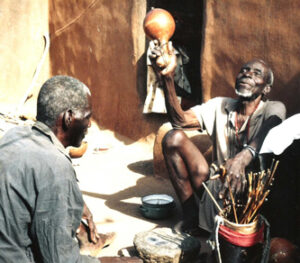
Divining session in Wiaga-Badomsa
Before a funeral celebration is held, the compound head always pays numerous visits to diviners. Immediately before the start of the Kumsa celebration, he asks the diviner about the organisation of the funeral and about its leaders (elders, kuub nyam), who will make all the important decisions. Some leaders always come from a different section, which is usually a neighbouring one. A funeral celebration in Wiaga-Sinyangsa-Badomsa is probably always conducted by elders from Sinyangsa-Kubelinsa; for Sandema-Kalijiisa, I know of two funerals in which elders from the neighbouring Bilinsa section took over the leadership.
Danlardy Leander (fn 94,86b): For the funeral celebrations of Abonwari, Atiim, Leander, Atoalinpok, and Maami, this neighbouring section [was] Kubelinsa, and the selected elders arrived at the funeral compound shortly before the Kumsa began. They took their seats in the kusung dok (meeting room with closed walls), discussed the feast, and then were served millet beer and millet water.
4.1.4.5 Preparatory meeting one or more days before the celebration
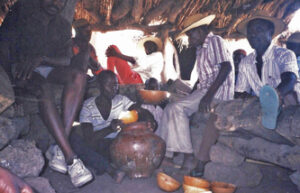
Serving millet beer in the kusung
Anyenangdu’s Kumsa was held on 28 February 1991: Three days before the start of the celebration of Anyenangdu’s Kumsa, the organisers and elders from Anyenangdu Yeri consulted with each other in the kusung. Anamogsi, Atinang, Ansoateng, Atupoak, Akayabisa, and Akabre conferred separately in the cattle yard (see photo). They sent some of their party to the elders in the kusung to inform them of their decision (e.g., a separate funeral for Aluechari’s sons should be held).
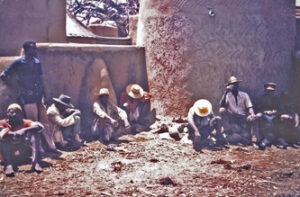
The heads of the ko-bisa have gathered for a separate meeting in the cattle yard.
The elders were sent a pot of pito and a bowl of millet water; Akperibasi (Abasitemi Yeri) distributed it (see photo). Then they were shown five bottles of gunpowder and the shotguns (da-guunta, ‘buried guns’) to prove that they are well prepared for the funerals; the gunpowder was tested by firing a shot.
Aduedem 2019: 13: …the sons or relatives call the yie-nyam (landlords) to the house and inform them that they should perform their funeral for them (ni kum ti kuumu te ti). When they [select] the day…another announcement [will be sent] to all that they will be removing Mr A’s mat the following day (as usual, young men are sent to the houses to inform them).
4.1.5 Going to the market
The procession to the market seems to be rarer and less official in Wiaga than in Sandema. In any case, the deceased person must have been old and respected. I only witnessed this procession once during the Juka celebration at the Wiaganaab’s compound, which is situated immediately next to the market.
Godfrey Achaw (fn 73,46, 49a): On the market day before the funeral celebration, all the musicians parade to the deceased’s house. They then go to the market with residents, neighbours, and relatives. The men of the section each wear animal skin (of cows, goats, or sheep) around their hips and an axe (liak) over their shoulders. They parade around the market and announce that a funeral celebration will be held the next day. There is much drinking, and the chief mourner must supply the musicians with millet beer. The music group consists of drums (especially ginggaung), flutes, and horns. In the evening, everyone moves to the house of mourning and stays there. The funeral celebration begins shortly after noon, as people want to go home in the morning to feed their cattle, etc.
4.2 Chronological listing of the events of the Kumsa celebration
The course of the first celebration for the dead extends over 3–4 days; if this includes a day of rest (vuusum dai), the celebration may last up to five days. The frequently expressed assertion that the celebration of a deceased woman lasts four days and that of a man lasts three days does not always seem to be in line with the practical application of funeral rites, especially as some (e.g., war dances) are omitted in a celebration for only one or more women (e.g., in Longsa 2011). The names for the individual days of funeral celebrations are manifold:
The first day can be called the kalika (sitting), kuub kpieng (great funeral celebration), or taasa yiika dai (removal of mats).
The second day is called the tika dai (assembly day) or leelik dai (war dance day). Azognab also calls it the kuub-guka dai (see below) and yiili siaka dai (day of dirge).
The third day is called the kpaata dai (shea butter day) or kpaam tue dai (shea butter and bean day).
The fourth day is called the gbanta dai (divination day).
A rest day (vuusum dai) can be inserted before the kpaata dai (see above).
This sequence of events has been confirmed many times by my visits to funeral celebrations in Wiaga and Sandema and by my informants.
E. Atuick (2020: 38f.): Where a deceased woman is among those for whom the funerals are performed, there is a mandatory rest day on the third day called vuusum [resting]. Where the funerals involve only deceased males, there is no vuusum during the funeral performance.
Azognab (Sandema-Abilyeri, information from Siniensi) describes the sequence and significance of the first two days differently from the above scheme:
The following information was gathered in an interview on the number of days taken for the dry funeral [endnote 70]. The period for each funeral ranges between three and four days, but that of chiefs and yeri-nyam or kpaga (elders who are family lineage heads) may be longer. The first day of the ‘dry funeral’ celebration is the kalika dai (literally, the ‘sitting day’). The kalika dai is applied to funeral celebrations of traditional leaders such as chiefs, teng-nyam, and yeri-nyam (family heads). The second day is the kuub-guka dai (literally ‘the day of burial’, when the death mat that represents the deceased person is disposed of). The ordinary funerals start on this day; in this case, the day is called the yiili siaka dai (literally, ‘the day of dirge’). This is followed by the kpaata dai (‘shea butter day’). However, if the deceased was a female, a chief, teng-nyono or a family head before his death, one day of rest, described as the vuusum dai, is observed before ‘the shea butter day’ [endnote 71]. The fourth day is the gbanta dai (day of divination) [endnote 72].
4.2.1 First day: Kalika or kuub kpieng dai or taasa yieka dai (removal of the mats)
4.2.1.1 Informing the ancestors through sacrifice (not observed)
4.2.1.2 Gathering of elders and neighbours
Awuliimba’s Kumsa, Sandema-Kalijiisa (fn 88,223a), 7 March 1989: At around 10 a.m. (or before?), the first consultations of Awuliimba’s sons and the co-organisers from the neighbouring Bilinsa section were held in the kusung dok. James Agalic explained to those present why some white people also wanted to participate in the rites.
Anyenangdu’s Kumsa, 3 March 1991: In the kusung, elders from various houses in Badomsa gathered: Angoong Yeri, Atinang Yeri, Atuiri Yeri, Akanming Yeri, Adaateng from Adaateng Yeri, Asante from Atengkadoa Yeri (= Asisapo Yeri), Akutinla (= Akutuila?) Yeri, Abui from Anue (= Aniok) Yeri, Akannyeba from Ayoaliyuema (= Ayualiyomo?) Yeri, and Amanchinaab from Amanchinaab Yeri. The following men were present from Kubelinsa: Akpiuk, Ayiruk, Adaanuruba, Aniyeng. In addition, the elder Ateng-yong from Akan-nyevari Yeri and Akayeng and Brunu from Akayeng-Yeri (all Sichaasa), were present. Kubelinsa led the discussions, but Badomsa men always joined in. After a consultation, the elders in the kusung reaffirmed the decision that it was right to bring forward the funeral of Anyenangdu (see 4.1.4.5); two younger men – Asante and Abui – went to Anamogsi to inform him of the elders’ agreement. After being served millet beer, they accepted the funeral.
Funeral at Atinang Yeri (fn 06,6a), data collected by Yaw: In mid-March of 2005 from 2.00–5.30 p.m., a meeting took place that was attended by the Badomsa neighbours (Amoak Adum, Abuuk, Ansoateng, Akaayaabisa, Aleeti, who represented his brother Asuebisa, Ayuekanbe, Afelibiik Abuumi, Anyik, and, later, one of Atupoak’s sons). Anamogsi was in the kusung only on the first day, but he had to provide all the food, drinks, and other supplies. The men in the kusung asked him if everything was ready.
Aduedem 2019:14: When the ko-bisa and other people gathered on that day, the sons or relatives prepared three calabashes of zo-nyiam, three calabashes of groundnuts, and drinks (three bottles of akpeteshi). They gave a calabash of zo-nyiam and groundnuts and a bottle of the drink to the elders (both yie-nyam and ko-bisa) in the kusung and to the women inside the dabiak.
4.2.1.3 Showing the millet beer produced
Anyenangdu’s Kumsa, 3 March 1991: Anamogsi showed the elders three pots of pito (one for Anyenangdu, two for the other funerals) to show that all preparations had been completed.
4.2.1.4 Weapons are brought to the granary
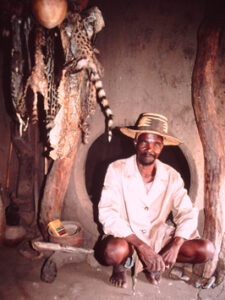
Anamogsi preparing the weapons in the ancestral room
Anyenangdu’s Kumsa: 3 March 1991, around 9.00 am: Anamogsi prepared the weapons (bows and quivers with medicine) of his father, Anyenangdu, in the dalong (kpilima dok).
Later an axe (liak) and a battle axe (kpaani) were added to the objects near the granary.
Awuliimba’s funeral, Sandema-Kalijiisa-Anuryeri (fn 88,223b): After carrying the mats out to the cattle yard, Awuliimba’s eldest son fetched the deceased’s bow and quiver from the ancestral room and walked with them to the central granary in the cattle yard, where he fastened the weapons to one side.
Funeral at Agbain Yeri, Wiaga-Yisobsa (fn 01,3a): On the afternoon of the second day, the following things were at or near the granary: one quiver, one bow, many calabashes, one metal trunk, and one trunk with clothes of the dead.
4.2.1.5 Entertaining guests in the kusung with millet beer
4.2.1.6 Signalling the start of the celebration with a firecracker shot
4.2.1.7 Closing the central granary (bui lika)
Anyenangdu’s Kumsa (fn 94,87b; 97,51a; 9763b*): The upper opening of the central granary was [halfway] closed (bui lika) on the first day of the Kumsa funeral after the first song (yiili) and was reopened (bui laka) at the end of the fourth day (gbanta dai).
4.2.1.8 The elders, singing kum yiila, dance to the granary (on several days)
Anyenangdu’s Kumsa: The elders danced to the granary (bui) of the deceased and back to the kusung dok. They sang funeral songs (kum yiila).
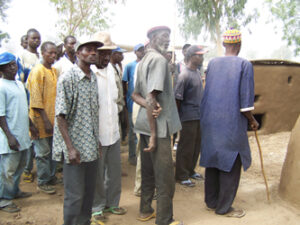
Singing Elders move to the granary (Guuta)
Funeral at Adiita Yeri, Wiaga-Yisobsa-Guuta: The elders paraded four times from the kusung dok to the bui (at 2.35 p.m., 3.44 p.m., 4.07 p.m., and 4.48 p.m.); each procession lasted about five minutes. The men’s group’s lead singer and musical leader was Akanbong, who is from another Guuta compound.
Funeral at Asebkame Yeri, Wiaga-Chiok (fn 88,120b): On the gbanta dai (divination day), the dirges had to be cancelled – there were not enough singers as, in Sandema, the Agric Show was on the same day.
Yaw (fn 97,19b), regarding the kum yiila of the men: The lead singer is chosen by the men in the kusung dok at the planning stage (before the funeral celebration begins). They usually choose the eldest, who hands over the position to the best singer in the group. After the initial intonation, a second unnamed singer spontaneously joins in. If no one repeats the first verse, the first singer will have problems. The first and second singers sing the same phrase, but the first one sings louder.
Danlardy Leander (fn 94,86*): The elders’ processions take place on the first, second, and fourth days.
U. Blanc (2000: 138): While the men sing their first four kum yiila, the women are not allowed to lament or sing, nor should musical instruments be played.
Aduedem (2019: 14): A male singer intones the funeral song at the main entrance, and all join in the chorus and move to the mat and back again. He intones the song once again, and everyone joins; they enter the kraal again and back outside. After the second singing, the sons bring a fowl, saying: ‘We are giving this to our father.’
Azognab (2020: 43) (Information from Anab Anakansa, Sandema): The traditional status of the deceased before his or her death determines whether ginggana nakka (beating of cylindrical drums) should accompany the dirges of the men or not. [Men begin singing] the dirges before the women.
p. 43f.: …dirges [are sung] around the house if the deceased persons are women, landlords or chiefs. For the funerals of ordinary men, the men’s dirges are sung from outside into the cattle yard and back up and down before the nang-foba.
4.2.1.9 Zong zuk cheka drumming on the flat roof

Drummers on the flat roof (Anyenangdu Yeri), 1991
Anyenangdu’s Kumsa, 3 March 1991 after 2.30 p.m.: Musicians played the drums on the flat roof to the left of the main entrance. The dunduning drum and the sinleng double bell were played in the cattle yard.
U. Blanc (2000: 136f and 145): This [drumming] and firecrackers are used to announce the beginning of the funeral celebration (darika, ‘proclamation’) to the neighbouring sections. The intonation of these rhythms outside the funeral celebration is considered taboo (kisuk).
4.2.1.10 Naapierik ginggana (‘war dance-like dance’)
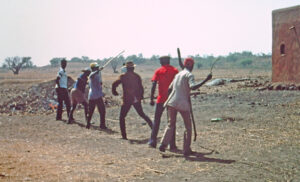
Naapierik ginggana in Anyenangdu Yeri, 1991
Anyenangdu’s Kumsa, 3 March 1991, after 2.30 p.m.: Dancing towards the tampoi, men from Badomsa performed a war dance-like dance with simple sticks. This group of men was comprised of Akansuenum (Asisapo Yeri), Aparik-moak (Aparik Yeri), Bawa (Akpeedem Yeri), Atupoakbil (Angoong Yeri), and Abui (Aniok Yeri). The first of each dance phase to reach the tampoi left the group.
Godfrey Achaw (fn 73,47b): [F.K.: Is nagela here identical to naapierik ginggana?] Nagela dances are performed at the rubbish heap. Although the nagela dance is usually not danced by women, here, men and women dance in mixed groups of two, one behind the other. There is a hole in the tampoi. Before someone starts dancing, they put some money in this hole. It is intended for the musicians. All relatives of the deceased must dance or at least give some money. The male or female chief mourners may kill a live chicken at the hole and then throw it in. After this dance, the distribution of gifts begins (see siinika).
U. Blanc (2000: 137): Some informants place the naapierik ginggana ritual immediately after the zong zuk cheka and others after the burning of the mats (tiak juka).
4.2.1.11 More death mats are collected from neighbouring compounds
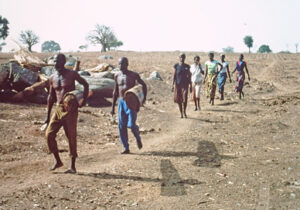
Two death mats are taken from Atinang Yeri.
Anyenangdu’s Kumsa, 3 March 1991, 3.30 p.m.: Aboali (Atinang Yeri), Asie, and the gravediggers Adok and Akpeedem went to the neighbouring Atinang Yeri to fetch the mats for two more funerals (‘ngari kumu ta jam’). Ali Amuning (the younger full brother of Atinang) and Awogmi (Angmarisi’s son). Anyavoinbey from Awala Yeri carried a bow and quiver; Apintiiklie from Aninama Yeri carried 2–3 calabashes. The two dead people from Atinang Yeri were included in Anyenangdu’s funeral celebration.
Funeral at Adiita Yeri, Wiaga-Yisobsa-Guuta. At 2.48 p.m., almost the entire funeral party (except the elders in the kusung dok) moved to Awusumkong Yeri (also Guuta), about one kilometre away, to collect the mat of a related deceased man. The mat, two bows, a quiver, and a cloth bag with the cloth for the mat were carried to Adiita Yeri by gravediggers and placed there at the bui. Five other mats were also taken from Awusumkong Yeri but were not funeral mats. These mats were gifts and were thus not carried by gravediggers.
4.2.1.12 The eldest son and the impersonator put on the deceased man’s clothes.
Anyenangdu’s Kumsa (fn 94,22a), 3.3.91, 16.00: Anamogsi, the eldest son of the deceased Anyenangdu, put on his clothes. This action cancelled a taboo that had existed since Anyenangdu’s death [endnote 73]. Imitator Agoalie put on these clothes immediately afterwards.
4.2.1.13 Shooting arrows
Anyenangdu’s Kumsa, 3 March 1991, around 4.00 p.m.: After Anyenangdu’s eldest son and the impersonator were dressed, an arrow (pein) was shot into the bush (uncultivated land).
F.K.: I have not heard of this custom anywhere else nor received any reason for it.
4.2.1.14 The widows go to the death mat at the granary
Funeral at Adiita Yeri, Wiaga-Guuta (I was only permitted to observe this ritual in Guuta; no photos were allowed there): The widows went to the death mat at the granary. I saw a widow touch the mat (of her deceased husband?) three times.
4.2.1.15 Sinsan-guli chants (women singing to the accompaniment of basket rattles)
These chants occur on the first and second days. Notably, they are still performed on the fourth day in Wiaga-Sinyangsa and Yisobsa but not in Wiaga-Chiok. U. Blanc writes that, according to some information, the sinsan-gula are no longer played on the fourth day.
Funeral at Akadem Yeri, Wiaga-Yisobsa (fn 88,200a+b), 31 January 1989: At noon on the funeral’s gbanta dai, women also sang and beat sinsan-guli rattles at the dressed granary (bui).
Funeral at Acha Yeri, Sandema-Chariba (fn 88,221b + 223b); on 5 March 1989 (gbanta dai): In the cattle yard, a hut was erected of millet stalks and left open at the sides. Women from Chana were sitting under it, rattling in front of the straw mats. Their leader (and pre-singer) was Akututera (Ayanaab’s Kasena wife), who married in Badomsa. A busik basket was available for donations. On the thatched roof were bundles of millet seeds.
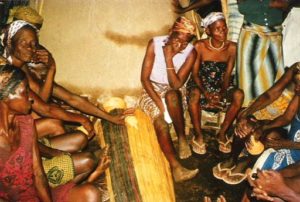
Sinsan-gula women in Sandema-Choabisa
Funeral at Atekoba Yeri, Sandema-Choabisa (fn 73,61): The death mat was lying in the cattle yard, and the singing sinsan-gula women were sitting around it. On the mat of the dead man were his zu-kpaglik (neck support) and horsetail fly whisk. The dead man’s clothes and red cap were hanging on the granary; next to them was a wooden chest studded with cowries and holding the dead man’s calabash helmet and other things.
Funeral at Adiita Yeri, Wiaga-Guuta (fn 2008, 15b): After the widows had moved to the mat at the granary, women with small, black sinsan-gula rattles situated themselves around it. Their leader was Ayomalie’s mother.
Awuliimba’s funeral, Sandema-Kalijiisa (fn 88,225b), 9 March 1989: On the gbanta dai, the leader, Akututera (a Kasena wife in Kalijiisa), complained that all the income (of the sinsan-gula women) had gone to the Bilinsa women. She would have agreed to one-quarter of the income for the Kalijiisa women. Besides, the Kalijiisa women had already participated in the fresh funeral.
Yaw (fn 97,19b), regarding the sinsan-gula yiila: A female lead singer begins (Yeri), a second woman alone takes over the next line, and then everyone joins in. Sometimes, there are also three lead singers or one lead singer sings the first line alone twice. The sinsan-gula women choose the lead singer at the beginning of the funeral celebration. She is usually the eldest and can pass this task on to another woman. The second singer is not appointed.
U. Blanc (2000: 138): The women begin their funeral songs after the zong zuk cheka at the death mat in the cattle yard. The songs consist of alternating singing by one or two lead singers and the choir. They are constantly accompanied by sinsan-gula rattles.
E. Atuick 2020: 72–73 (on the fourth day after the kusung visit [of the impersonator with the sinsan-gula women]): After spending some time in the kusung, the leader rises and goes back into the compound amid singing and dancing by her and her entourage. As soon as they go inside the compound, they continue the singing of dirges, some of which contain insults and words of mockery directed at the men. In one of the songs [that] I heard while observing the ritual performance, the lyrics contain the following lines:
I am going to get a dog instead of giving birth to men, who will not stay at home but run off with women while hunger kills us. If they are not running away with women, they are probably drunk and lying in a gutter somewhere along the road. Is it not better to have a dog as a puppy instead of giving birth to misfortunes as children?
Thus, through the singing of songs, Bulsa women have the licence to direct words of criticism, mockery, and vulgar insults at their men without getting into trouble, although the men do not countenance such behaviour in ordinary times. Bulsa culture frowns upon women talking back at men or openly criticising them in public, but occasions such as funerals provide women [with] opportunities to openly criticise or take on [confront?] the men through music and other means. It was, therefore, not surprising that I heard many songs in which the women criticised, mocked, or insulted the men during my observation of the rites.
While the singing continues, the men, led by the chibouk in charge of the funeral, gather an animal, millet, sorghum, and drinks (especially pito, a beer made from sorghum or millet). Millet flour is mixed with plenty of water in a giant calabash and presented to the women. [A spell is cast] on any witch or wizard who might want to poison these things. The animal and foodstuffs are meant for the preparation of ritual food, while the drinks and flour in water are for the refreshment of the women who sat throughout the night preparing funeral meals and mourning the deceased by singing dirges.
4.2.1.16 Cherika or cheri-deka (imitation)
These dramatic scenes can occur on the first, second, and fourth days. A deceased male is usually imitated by one of his sons’ wives. This woman’s choice depends on her genealogical position as well as her acting skills, as she must perform short impromptu episodes from the deceased’s life.
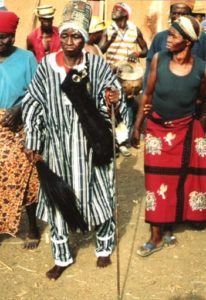
Anyenangdu Yeri: Agoalie imitating Anyenangdu, her father-in-law, 1991
Anyenangdu’s Kumsa: Blind Anyenangdu was imitated by Agoalie, his daughter-in-law, who made her way through the crowds with Anyenangdu’s iron walking stick. She was wearing Anyenangdu’s clothes and his hat and moved with the sinsan-guli women through the compound to the kusung dok. There, she sat down with the elders (Danlardy: ‘Ba ta yeri-nyono a nyini a pa te kusung dema’). According to Danlardy, the conversation began with the following question to the elders: ‘Why are you here in this compound?’ They replied, ‘Anyenangdu died, and we are here to hold his funeral’. After more questions and answers, the impersonator and her companions returned to the compound, where they sat down near Anyenangdu’s granary. Anamogsi gave them a bottle of akpeteshi, a pot of millet beer and two large calabashes of millet water.

Agoalie (= Anyenangdu) in the kusung dok with the elders
Awuliimba’s funeral, Sandema-Kalijiisa (fn 88,225b) 9 March 1989 (before the killing of the donkey): The wife of Awuliimba’s eldest son imitated the dead man. She was wearing a man’s smock, sat down in the kusung, and demanded kola nuts, which she buried in the ground so that no one else could find them. She was addressed as Awuliimba. Later, a second woman in a male costume arrived. She imitated one of Awuliimba’s sons, who died in 1987 and whose Kumsa had already been held.
In another scene, Awuliimba’s imitator pacified a screaming woman who wanted to return to her parents because her husband had beaten her. She (as Awuliimba) tried to comfort her and keep her in the house. Apart from Awuliimba’s impersonator, his elder daughters and his brother’s daughters also wore male smocks.
Funeral at Agaab Yeri (fn 08,15b) Wiaga-Yisobsa-Chantiinsa, 17 February 2008: The impersonator was wearing a man’s clothes and a straw hat.
Scenes played at 9.19, 11.53, and 11.58 a.m.: As the deceased man had been very argumentative, the impersonator involved other men and women in fights and verbal arguments.
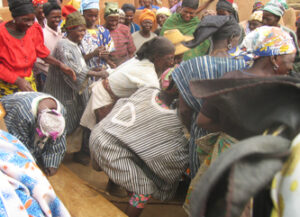
Agaab Yeri: The impersonator scuffling with an adversary of the deceased man
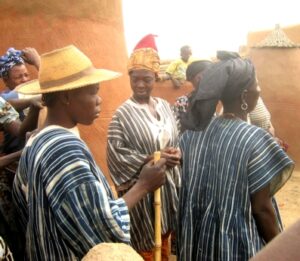
The imitator (left) at Agaab Yeri
Funeral in Sichaasa, Wiaga (fn 88, 185b), 19 January 1989: On the second day (tika dai), the impersonator of the deceased women was the eldest woman of the house. Like the deceased during her lifetime, the impersonator wore only leaf clothes and carried an empty busik basket on her head.
Funeral at Adiita Yeri, Wiaga-Yisobsa-Guuta (fn 08,15b), 22 February 2008: Only after burning the mats at around 6 p.m. on the first day (kalika) did the impersonator visit the kusung dok and talk to the elders there. She rolled cigarettes and smoked. Outside, she engaged in an agitated discussion with another woman.
Funeral at Atinang Yeri, 27 January 2006, Wiaga-Badomsa: Atinang’s impersonator was Atakabalie, the wife of his son Anyik. Atinang’s brother, Angmarisi, was imitated by another woman whose name Yaw cannot remember. Agoalie was imitated by Ajadoklie (daughter-in-law of Agoalie’s co-wife Agbiera). The unmarried Kweku was considered a child (biik) and was not imitated.
Robert Asekabta, regarding the term cheri: Cheri denotes simply the activities, behaviours, and attitudes of the person whose funeral is being performed. Cheri-deka is normally performed in the case of an elderly person; the person who performs this function is typically the wife of the deceased’s son or his brother’s son’s wife.
The che-lie [Atuick: cheri-deiroa, meaning ‘impersonator of a deceased person’] is usually responsible for the following duties:
(1) Taking the mat(s) to the granary (bui); (2) Brewing the pito near the bui; (3) Supervising the shea butter extraction from the shea nuts; (4) Boiling the beans; (5) Boiling the bitter pito (da-tuek); (6) Smearing all the children and grandchildren of the deceased, his brothers and cousins, etc., with red laterite clay-paint.
In other words, the che-lie acts as the manager of the funeral in the nangkpieng (cattle yard).
Margaret Arnheim, Gbedema (fn M28a and 34b): Actions of impersonators are not bound to gender. They are often determined while the person is still alive if it is seen that someone can imitate the deceased well. It does not have to be a specific relative. Another woman usually imitates a dead woman; a man usually imitates a dead man.
(fn M37a): The female impersonator would wear the dead man’s red cap if the dead man was older and wore such a cap. It is said: ‘Wa vug wa zutok’ (‘She [the impersonator] wears [literally ‘covers’] his red cap’). For example, if a small child led the deceased during his lifetime, the same child would lead the impersonator.
Leander Amoak (fn 81,28a): In the funeral celebrations of both men and women, the impersonator is female. In the case of a man’s funeral, it is a daughter-in-law of the deceased; in the case of a woman’s funeral, it is a relative from her parental home. This woman is also responsible for many other activities; for example, she carries the baskets outside and paints relatives with red clay. In the case of Leander’s brother Atiim, it will be his daughter-in-law (Michael’s wife); in the case of Abonwari (a nineteenth-century ancestor), it will be Leander’s first wife, Atigsidum. The woman imitates the dead man without concern for respect: If the dead man was loud, she would constantly shout; if he drank a lot, she would play the drunkard. The Buli name for imitator is che(ri) dieroa.
Danlardy (fn 94,91b*): Che-lieba imitate the dead person. There is no actual meaning of ‘che’.
Yaw (fn 01,2b): Imitation at a worldly feast (tigi) is taboo (kisuk).
U. Blanc (2000: 146): The [imitation] takes place on both the first and second days. As a rule, the impersonator is a daughter-in-law of the male or female deceased. In principle, any relative can take on this role.
Aduedem 2019: 49: The ‘cheri-deka’ is meant to [evoke] vivid memories of the lost soul. It also gives a [sense] of the life lived by the dead person to people who never had the opportunity to know the person in life. The mock play, when done well, especially by a spectacular person, could attract much attention and give colour to the celebration. In all of them, people are reminded of the dead person’s life and how the person would be missed. Others, too, get to know how the dead person once lived his life.
Adumpo Emile Akangoa, Facebook group Buluk Kaniak, March 29, 2019: Although globalization has had a toll on the cohesion of our extended family system, funerals are still being communally performed in Buluk. Cheri-deka must not necessarily be done by daughters-in-law in the nuclear family. Whenever no daughter-in-law in the nuclear family plays that role, they get somebody from the extended family to do it.
Azognab 2020: 49 (Information from Akaalie Aginteba, Sandema 2018): The name of the meal [cheri saab] is carved from the cheri-dierowa (a daughter-in-law of the deceased who imitates and acts like him or her during the funeral). The cheri-dierowa wears the deceased’s clothing and acts like they did when they were alive. She does this from the beginning of the kuub-Kumsa to the end. Usually, the imitation [recalls] the past good and bad character of the deceased. It is often claimed that the spirit of the deceased person in question could possess the ‘imitator’ (cheri-dierowa) to portray the exact character of the deceased during the funeral.
The significance of the cheri-deka (…imitating and acting out the deceased’s lifestyle…) is that it reminds the community about the deceased’s past character, whether good or bad [endnote 74]. The cheri-deka, therefore, serves as a lesson for the living, who may endeavour to lead good lives so their cheri-deka will be praiseworthy.
p. 45: Every Bulsa funeral has personnel who are directly in charge of the whole ritual apart from the elders in the kusung dok …This [group] usually comprises the yeri-lieba (meaning ‘daughters of the house’) if the deceased was a man or the che-lieba (married women in the family lineage, who hail from the same village or town where the deceased hailed from) if the deceased person was a woman.
E. Atuick 2020
Evans Atuick wrote his MA thesis on how women participate in funeral rituals: ‘Women, agency, and power relations in funeral rituals: A study of the Cheri-Deka ritual among the Bulsa of Northern Ghana’.
This thesis is the most comprehensive account of the cheri-deka ritual to date. Other rituals are also included and described by Atuick in the correct order. Therefore, the description of the cheri-deka and the cheri-deiroa (Atuick, pp. 67–99) will be reproduced here in only a slightly abridged form. Notably, the day in the first funeral celebration during which certain partial rituals are performed is not always clear in this work.
Atuick p. 65: Ideally, the wife of the first son of a Bulsa man or woman must play the role [of the cheri-deiroa]…
p. 67ff: …the cheri-deka ritual commences on the second day of the kuub-kumka, when the ta-pili… is discarded [after the war dances (leelika)]… The cheri-deiroa [che-dieroa] is told by the chilie [female master of ceremonies for the funeral] to dress up in her father’s tangkalung… if the deceased was a man… But if the deceased were female, she would be told to put on leaves, pick her mother’s sapiri… and busik and go out. In the case of a deceased male, she must join the men for the leelika [war dance] around the compound three times; in the case of a deceased female, she must… dance along as they play the drums around the compound four times. When these ritual dances are over, the cheri-deiroa can disrobe… and perform her normal chores. … However … the deceased persons’ [relatives] will engage with her similarly [F.K.: mockingly?].
On the kpaata dai…the cheri-deiroa must be the first person to start the fire used for cooking the beans… She cracks the first shea nut… [F.K.: See the section on kpaata dai, 4.3.4.1].
…Meanwhile, when the men are sharing their share of the cheri-deka meat [F.K.: on the fourth day of the Kumsa celebration], they will call the cheri-deiroa and give her the chest of the animal, [which] is usually reserved for landlords. This symbolises her status as a landlord during her performance as the living copy of [a] deceased elderly [man]. After taking her share of the meat, she goes in search of the deceased’s sons-in-law, who are there to mourn their parent-in-law. She will play with or talk nicely to sons-in-law who were on good terms with the deceased person before dying but will attack others who were never on good terms with him or her. She does similar things to friends and other relatives of the deceased, treating each as her deceased parent-in-law would have dealt with them in his or her lifetime. In return, understanding the game, they [the addressed or insulted people] play along and even give her money or other gifts [that] they used to give to the deceased in his or her lifetime on earth as a way of appeasing the soul of their parent-in-law, friend, or relative.
Moreover, on this final day [of the Kumsa], the deceased’s grave is plastered as part of the funeral rites, and the cheri-deiroa again plays a role. The male chibouk who is leading the funeral will send a message to the female chilie to send the cheri-deiroa to them to help put the grave in shape.
A Bulsa family may perform the kuub-juka rites immediately after the end of the kuub-kumka celebration. In this case, the cheri-deiroa has no break in the performance of her impersonator role but will continue for the next four days throughout the Juka rites until the end. However, [in cases when] the Juka rites are postponed to a future date, be it months or years, the cheri-deiroa can keep her role in abeyance until the family is ready before resuming her duties and responsibilities to make the funeral successful.
[F.K.: The following text refers to the bogsika dai, which often occurs before the first day or on the first day of the Juka funeral:] The kuub-juka rites typically start with a journey to the maternal uncle’s compound of a deceased man or the paternal compound of a deceased woman for two main reasons: to collect things for the performance of the final rites, and to inform them about the intention to dispatch the restless soul of the deceased to the land of the dead, where he or she will find lasting, peaceful rest among his or her forebears. The cheri-deiroa must dress up in the deceased’s clothing and animal skin, carry his walking stick, etc., if he was a man or carry her basket and food stick if she was a woman and follow the travelling team to the deceased’s compound. The travelling team [to the compound of a deceased man’s maternal uncle] usually includes the children of the deceased, one or two of their relatives, the cheri-deiroa, and her female escort(s). The travelling team that goes to a deceased woman’s paternal compound includes her children, the san-yigmoa [her marriage intermediary], one or two relatives, the cheri-deiroa, and her female escort(s).
As soon as they arrive at the compound, the cheri-deiroa continues her role as an impersonator of the deceased by reenacting the same kind of interaction that [the person] had with his or her relatives [while] alive and [when visiting] them. She will play with those she knows the deceased had good relations with and attack others that he or she disliked while alive. Some of these people who fully understand the game of cheri-deka will immediately engage the cheri-deiroa in the same manner [in which] they dealt with the deceased [immediately when] she appears at the compound in the deceased’s apparel. She must equally respond to their acts or speeches as if she were the deceased person who is still alive and interacting with them.
While this is going on, the delegation enters the compound and sends for the elders to inform them about their mission. The leader of the delegation, speaking on behalf of the rest, exchanges pleasantries with the elders and says to them, ‘Your son (or daughter) wants to go home, and that is why I have come to inform you before giving him/her permission to go home and rest.’ After this, the delegation is fed and refreshed by the family before rising up to start their compound-to-compound rounds within the lineage [to collect] foodstuffs, especially millet and sorghum, as well as guinea fowl and other domesticated fowl that they can catch or kill. [To collect these foodstuffs and birds] during this compound-to-compound journey, the delegation will visit every compound on the maternal side of a deceased man’s lineage or the paternal side of the deceased woman’s lineage… The cheri-deiroa, just like her late parent-in-law used to do, has a licence to play with any of her uncles by catching any livestock that belong to him without any resistance. Hence, with the assistance of her team, she can catch and kill as many birds as she can, as long as the birds are found in any of the compounds in the paternal lineage of the parent-in-law she is impersonating. After they have covered every compound within the lineage, collecting everything they need to collect, they will return to the original compound the deceased is related to or hails from. By the time they arrive there, there is enough food and drink for them to feast, after which all the households of men within that compound will contribute their share of foodstuffs and birds to add to whatever they have collected from neighbouring homes before returning home.
(p. 81) …The final rites of a man’s funeral occur on the fourth day [of the Juka] when the louk [lok] is broken in the middle of the compound’s yard. The cheri-deiroa has a role to play here. She must be present when the birds collected from the deceased [man’s] mother’s compound are dedicated to the spirit of [the] deceased man’s louk before it is broken and shattered in the main yard of the compound…Following the war dancing, the eldest son of the deceased performs the final sacrifice of the rites on the left wall of the main entrance… While standing there, he gathers all the live fowls brought from the earlier visit to his late father’s mother’s lineage and those donated by friends and sympathisers to help him complete his father’s funeral rites and sacrifice them on the wall. He does this by hitting the fowl, one by one, against the wall to die. While their blood flows down the wall, he says, ‘Ba ko parik! Ti kowa kumu yai nueri kama!’ [‘They have killed a wall! Our father’s funeral is now over!’]. This sacrifice marks the end of the funeral rites for the deceased man and, by extension, the role of the cheri-deiroa. The next thing [to be done] is for all the dead birds to be plucked and cooked for all present, including the cheri-deiroa to eat to their satisfaction before dispersing.
However, the Juka rites of a woman are much more complex, with the cheri-deiroa playing a much more influential role. In this case, women from the paternal home of the deceased mother-in-law must arrive on the evening of the third day of the rites to sleep over. They usually come with their own puuk (a ball-like object made from certain leaves [endnote 75] that symbolises a woman’s womb during funeral performances) to participate in the rites. As a group, the wives in the compound must acquire a puuk for the rites to commence. The cheri-deiroa must also acquire a puuk for the rites. The next morning, on the fourth and final day of the rites, the visiting women will take their puuk to the san-yigmoa’s compound, [handing] it over to him and [asking] him to help them present it to their sisters’ husbands. The san-yigmoa then leads them to the compound where the deceased lived, exchanges pleasantries with the elders, and hands over the puuk to them…
At the same time, women in the funeral compound are also preparing food that must remain on fire until those returning with the puuk and food from the san-yigmoa’s compound stand apart from the compound and send for the women inside to come and meet them. As soon as they get the message, the chilie will [ensure that] drinks, flour mixed with plenty of water, and saab [are] made ready for them to take along for those waiting outside. On meeting them, the women from the funeral compound and the cheri-deiroa will serve those waiting with the food and drinks they came with and collect the puuk and food brought from the san-yigmoa’s compound to take back inside the funeral compound.
The following day, all three puusa [plural of puuk] are taken back to the same spot where the women met the previous day and broken into pieces, except for the puuk provided by women of the deceased person’s compound, which is handed over to the cheri-deiroa for keeping. Thus, the puuk provided by the women from the deceased’s paternal home and the one provided by the cheri-deiroa are both destroyed, but the chilie presents the one from the wives from the compound sponsoring the funeral to the cheri-deiroa as an inheritance from her deceased mother-in-law. As the eldest son’s wife, the cheri-deiroa receives this puuk as the rightful inheritor of the deceased’s household and property, and she is expected to keep this until her demise. The Juka rites – and, by extension, the cheri-deiroa’s role – are finally completed when the compound elders kill and present an animal – usually a goat or sheep – to the deceased woman’s paternal relatives who had brought the puuk, which they take home.
4.2.1.17 Ritual treatment of relatives: hand rope or scarve, red cap, nabiin-soruk necklace, bell, painting with daluk clay
Applying cords and headscarves for wrapping around wrists is possible on all funeral days and times. A distinction should be made here: on the one hand are short knits (boom or buoom) and headscarves, which are placed around hands, and which are a symbol of friendship; on the other hand there are long knits, which are only put on close relatives of the deceased (‘to prevent suicide’).
Funeral at Adiita Yeri, Wiaga-Guuta (fn 2008,15b), 21 February 2008: On the first day at 5 p.m., a man appeared with a bundle of braided hand ropes, which he distributed. All children and other very close relatives received a rope for their left hands (followed by the painting and donning of the nabiin-soruk chain).
Awuliimba’s funeral, Sandema-Kalijiisa (fn 88,224a+b), 8 March 1989: On the second day, the women on the mat wove buoom strings. Originally, a piece of cloth was only wrapped (boblik) by the nong around the hand of his or her girlfriend or boyfriend. By contrast, in the case of the German guests Barbara Meier and Annette Schierwater, this was also done by a woman (Akututera?). On the gbanta day, the recipients returned the scarf to the giver with the money they had received and a surcharge.
9 March 1989 (fn 88,225b): After divining, the buoom strings that had been worn around wrists were placed next to the granary, and the widow’s strings were thrown over the nang-gaang wall.
Funeral at Asebkame Yeri, Wiaga-Chiok (fn 88,119b), gbanta dai, 6 December 1988, 1.15 p.m.: A lengthy, braided buoom rope (over one metre long) was wrapped around a fully dressed woman’s left hand in the cattle yard, in front of two chests containing the dead man’s personal belongings. She pulled the two existing and shorter knits on her hands up her arms. She was also given a nabiin-soruk necklace and a tall red cap. Her arms, legs, and face were smeared with red junung or daluk clay.
A woman with a red cap and black headscarf wrapped a thin twisted cord around her waist three times after she had cut it from a long cord (by placing it on the base of a large stone and using a small stone to slice it). Several women wore a twisted, sash-like cord over their chests and shoulders.
Funeral at Atekoba Yeri, Sandema-Choabisa (fn 73,60b). 18 April 1973: Women wore ropes or colourful scarves around their left wrists.
Danlardy Leander (fn 88,82a), 1995: In Badomsa, the widow’s cords are kept in the widows’ bedrooms after the funerals.
Ayarik Kisito, Zuedema (fn 73,311b): If a young man has a short cord around his hand, he has a girlfriend (nong) who has tied it. A wife never ties it to her husband’s wrist. In the case of married women, it is the husband’s mother; in the case of a man, it is his mother. In a nong friendship, the wife goes to her husband’s friend [a female nong] after the funeral with food and thanks her for helping. This friend (nong) is usually married, but even if she is unmarried, her husband can never marry her.
Margaret Arnheim (April 1980, fn M24b): A busum-boong, the cloth for the wrist, is always given to a male mourner by his girlfriend, but it need not always be his pok nong. A random person in relatives’ home often puts on the fibre cord.
Godfrey Achaw (fn 73,49a): All children of the deceased person are given a long rope on their left hand to prevent suicide. The rope is removed along with the washing away of the colour. The ropes are placed next to the pillar of the main entrance and are later burnt.
Yaw (fn 01,8b): A woman takes a rope or a headscarf and ties it around the wrist of a friend together with some money. More than five ropes or headscarves are possible. The return is again linked to a gift of money (according to financial circumstance), which does not necessarily have to be higher than the amount given. When returning the cloth, you can say that the money can be used for soap, as the cloth has become dirty.
Bell (logi)
Anyenangdu’s Kumsa: A bell was attached to Anamogsi, the youngest son of the deceased Anyenangdu. It can be worn around the neck or on the belt.
Awuliimba’s Kumsa, (fn 88,223b); 5 March 1989, gbanta dai: Akututera attached a bell to Clement Agalic’s belt and placed a plaited ribbon around his hand. Clement is the youngest son of the deceased; it is generally assumed that the closest relationship exists between a father and his youngest son. The bell is said to make it easy to find the youngest son and prevent suicidal intentions.
Funeral at Asebkame Yeri, Wiaga-Chiok (fn 88,120b): A boy of about seven wore a bell on his waist belt. He was supposedly the son of the head of the compound.

Nabiin-soruk necklace
Red caps and nabiin-soruk necklaces
These caps and necklaces are usually donned on the first day, but it is possible on all days and at all times of the Kumsa. The putting on of the red caps and the nabiin-soruk necklaces usually takes place at the same time. As explained below, the dressed granary in the cattle yard can also receive a red cap on a long pole.

Woman with red cap, painting and nabiin-soruk necklace (Agbain Yeri)
Funeral at Asebkame Yeri, Wiaga-Chiok (fn 88,119b), gbanta dai, 6 December 1988, 1.15 p.m.: After putting on a braided buoom rope, a woman was given a nabiin-soruk necklace (with striped rosetta beads) and a high red cap. She tied a black headscarf over it.
Anyenangdu’s Kumsa, first day, 5.00 p.m.: The youngest and eldest son of Anyenangdu (Anamogsi, the only child, is both) was given a nabiin-soruk necklace and a red cap. The necklace was made of rosetta beads, which were also used as currency in colonial times. It had previously belonged to an ancestor named Aluechari but could be used by both male and female relatives of Aluechari at funeral celebrations.
Funeral at Adiita Yeri, Wiaga-Guuta (fn 08,15b): After all the children had been painted, the youngest son received a red cap and the nabiin-soruk necklace.
Funeral at Acha Yeri, Sandema-Chariba (fn 88,221b); 5 March 1989, gbanta dai: The eldest daughter of the deceased person was wearing a pearl necklace and a red cap.
Margaret Arnheim 1978ff (fn M28a): In Buli, ‘zutok muning vukka’ means to ‘wearing the red cap of the deceased person’.
Danlardy Leander: Women whose whole faces are painted with red stripes also wear the red cap.
Azognab 2020: 45f. (his informant: Afrafrarik Atenalim, Sandema-Tankunsa 2018): When the ritual is being performed for someone who married elsewhere, daughters from the family are expected to visit the funeral while dressed in smocks and red hats (zutoak muina), with ropes in [around] their left wrists if the deceased was their real father or mother or even uncle or aunt. If they fail to come with these dresses, they will be offered some by the funeral personnel for a small amount of money.
Painting of close relatives
Daluk saka (sa = to smear; daluk = red laterite clay-paint) is the word for the ritual painting of bodies with red clay. Daluk must not be washed off until after the divination session on the gbanta dai, but it often disappears through sweat. This painting is possible on all days and at all times of the funeral celebration.
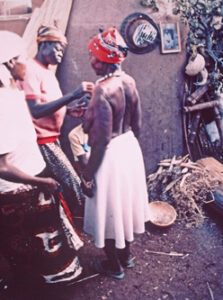
Painting in Anyenangdu Yeri, 1991
Anyenangdu’s Kumsa, 1991: At the death mat in the cattle yard, a woman smeared daluk paint on the faces and bodies of close relatives of the deceased, for example, his sons, and married and unmarried daughters. The painter was not from the mourning compound but from Abapik Yeri (Badomsa). She received money for her work.
Funeral at Asebkame Yeri, Wiaga-Chiok (fn 88,119b), gbanta dai, 6 December 1988, 1.15 p.m.: After putting on a long buoom rope and a nabiin-soruk necklace, the arms, legs, and face of a fully clothed woman were smeared with red junung or daluk clay.
Funeral at Adiita Yeri, Wiaga-Yisobsa-Guuta (fn 08,15b), 22 February 2008, 5.42 p.m.: After putting on the hand ropes but before donning the red caps and necklaces, a woman painted close relatives of the dead man in the cattle yard with daluk (she continued on the second day and on gbanta dai).
Awuliimba’s funeral, Sandema-Kalijiisa-Anuryeri (fn 88,224a); Video 3700, 8 March 1989: After 11 a.m. on the second day (tika dai), a woman in leaf clothing was painted with daluk in front of the mat. The white participants (including Prof. Schott) each received a long stroke of daluk on their forehead; sons and daughters received strokes like Bulsa tribal marks.
Funeral at Akadem Yeri, Wiaga-Yisobsa: Behind the granary was a pot of red clay for painting close relatives.
Funeral at Acha Yeri, Sandema-Chariba (fn 88,221b), 5 March 1989, gbanta dai: All close relatives were painted on the first day. On gbanta day, the paint on their bodies had disappeared through sweat.
Funeral at Agbain Yeri, Wiaga-Yisobsa (fn 01,3a): On the second day (tika dai) and after 4 p.m., an older woman painted the daughters’ faces and bodies with daluk clay.
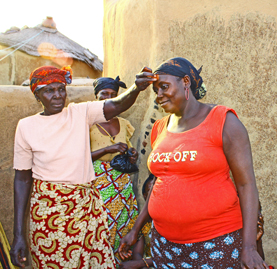
Painting in Longsa, 2011
Funeral at Atekoba Yeri, Sandema-Choabisa (1973): Close relatives were smeared with daluk all over their bodies; more distantly related ones wore only a red line on the left cheek (like a tribal mark).
Funeral at Ataamkali Yeri, Wiaga-Longsa, Afelik’s Compound (2011): On the second day (tika dai), close relatives were painted next to the mat inside the compound.
Danlardy Leander (fn 88,185b), 19 January 1989: Different stages of body paintings include the following:
a) Only one red stripe of daluk including white ashes is painted on the left cheek (Danlardy should also have been painted thus in Sichaasa).
b) The whole face is covered with red stripes. The women who receive such a paintings also wear a red cap.
c) The whole body is painted red. The women have a bare upper body; some wear only vaata (leaves or fibres) and a buoom band around their left hand. Many of such mourners wear nabiin-soruk necklaces around their necks.
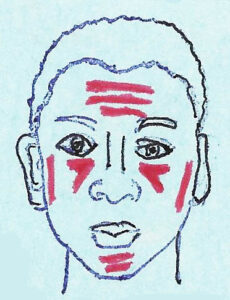
Information from Gbedema
Margaret Arnheim from Gbedema (fn M24b), April1980,regarding funeral painting: The closer the mourner is to the deceased as a relative, the more of the red laterite colour is applied. On each upper, middle and lower arm, non-regular strokes that are three fingers wide and approximately ten centimetres long are painted.
Yaw (fn 97,1b), information similar to Danlardy’s (fn 97,50b): The painting [of daluk] is intended to prevent the deceased from recognising close relatives [and taking them into the realm of the dead]. If one sleeps with the body paint still applied, it brings blessings.
Godfrey Achaw (fn 73,49a): All close relatives, especially the children of the deceased, receive painting on the whole body; other relatives only receive strokes (like tribal marks) on the cheek. The lastborn receives a particularly large amount of colour. The [earthen paint] is removed on the third or fourth day after the goat meat has been sacrificed. A full bath is not permitted beforehand, although hands and face may be washed.
Ayarik Kisito, Zuedema (fn 73,311b): [The deceased man’s children are painted red on the first day of a funeral celebration]. If you were only related to the deceased, you are given a ‘red mark on the left cheek’; the red colour is used to identify (mark) the children and [means] ‘You are in danger’ [to those who would harm those painted]. Enemies particularly want to harm the children of the deceased at a funeral.
U. Blanc (2000: 3): The red colour for sons and daughters must not be washed off until the gbanta dai. The cords must also be worn until then.
4.2.1.18 Processions around the compound
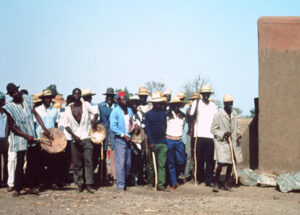
Procession in Anyenangdu Yeri, 1991
Dancing around Anyenangdu Yeri, 1991 (photo: M. Striewisch)On all days, groups of elders and guests can parade around the mourning compound, dancing and singing. As I observed in Awuliimba Yeri, Anyenangdu Yeri, Atekoba Yeri, Asebkame Yeri, and others, music groups accompany these processions.
Funeral at Asebkame Yeri (fn 88,120), gbanta dai: Guest groups danced around the house. The following two dances were performed: duelinka (slow) and na-gela (faster). These were often danced alternately, either in a single file or in a line.
Funeral at Atekoba Yeri, Sandema-Choabisa (fn 73,61a): On the first day (16.4.73), people paraded around the compound three times. After each procession, dancers and musicians came to the mat, drummed, and danced there.
(fn 73,63b), 19 April 1973: Only on the first day did there have to be exactly three processions around the compound; after that, the number was arbitrary, and a single procession was sufficient. Only three ginggaung drums were played as musical instruments.
4.2.1.19 Dressing the granary and objects of the deceased people in front of it
Awuliimba’s funeral, Sandema-Kalijiisa-Anuryeri, 1989: The gravediggers stuck a long pole into the granary (photography was strictly prohibited). They placed a colourful cloth over it and a white smock (garuk) on top. A red cap was placed on the top of the pole.
Anyenangdu’s Kumsa (1991): A large cloth that the deceased had worn as a toga (ga-tiak) on festive occasions was used to cover the granary (bui). The new mat was the final gift from the daughters of Anyenangdu and Atinang Yeri. A branch (of gaab) with leaves was intended to provide shade for the sinsan-gula women. On the right were the weapons (including a war helmet) and a photo of Anyenangdu.
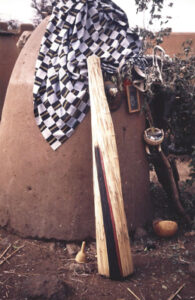
Dressed granary in Anyenangdu Yeri, 1991

Weapons, chests, and clothing of the dead in Asebkame Yeri
Funeral at Asebkame Yeri, Wiaga-Chiok (fn 88,120b): At the bui were two chests with the belongings of the dead man, a brown smock (garuk), and a blue cloth on top, as well as three bows, a war helmet, and a calabash with red clay for painting. The former belongings of the dead women were standing in front of the dabiak (courtyard): a very long sa-piiri stirring stick and destroyed pots.
Funeral at Akadem Yeri, Wiaga-Yisobsa (fn 88,197a), 28 January 1989: Note about the tika dai: The granary in the cattle yard had been dressed the day before. There was a red cap on top and a pot of daluk clay behind the bui; objects belonging to the dead were lying in several places (see photo).
Apusik (1989): The custom of dressing the granary is only performed for men who died at a very old age.
Azognab (2020: 43) (his informant was Anab Anankansa from Sandema): Some of the traditional belongings of the deceased, such as his smock, log-pak (quiver), bow and arrow, calabash helmet, kpaani or liak (axe), bunlok or foruk (travelling bag), and others (if the deceased was a male), are placed by the ta-pili (‘death mat’). If the deceased was a female, some of her clothes, pots, bowls, her local ‘meat basket’ or yolung, and other things that are considered [to contain] her ‘body dirt’ are all placed by the ‘death mat’ as if she is in the process of packing to make a journey to a distant place. I [Azognab] observed, however, that in modern days, the number of the deceased’s belongings placed in the cattle yard during funerals is minimised.
4.2.1.20 Nang-foba mat rites with chickens
The following mat rites are described by some informants as preparation for the nang-foba ritual; according to others (e.g. Danlardy), they are part of this ritual in the entire Bulsa region.
Anyenangdu’s Kumsa, first day, 3 March 1991, 5.30 p.m.: The death mats were brought from the ancestral room to the main courtyard, and the two gravediggers rubbed each one twice with various chickens, a piece of cloth, and Anyenangdu’s horsetail flywhisk. A rooster was used for Anyenangdu, the most important mourned person. The chickens were killed by hitting them on the ground and were then taken to the tampoi.
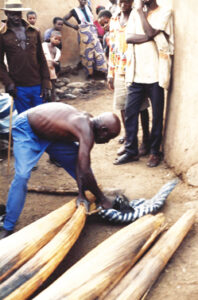
Rubbing the mats, Anyenangdu Yeri, 1991
This mat ritual usually occurs in the cattle yard (see nang-foba), but on this day, it was performed in the main courtyard (Ama dok), and women from the neighbourhood carried the mats to the cattle yard afterwards (ta-pila yierika).
Funeral at Atinang Yeri, Wiaga-Badomsa, Information from Yaw (fn 06,6): The gravediggers Ayogsi (Aniok Yeri), Musa (Achilim Yeri) and Atongka fetched the death mats (with the zu-kpaglik) from the kpilima dok of Anyenangdu Yeri to Atinang Yeri. Each mat was followed by at least one woman, e.g., Asiukpienlie from Anyenangdu Yeri and a ‘daughter’ from Atinang Yeri. They were placed in the Ama dok of Atinang Yeri (Yaw did not see the nang-foba ritual).
Awuliimba’s funeral, Sandema-Kalijiisa-Anuryeri: Two gravediggers entered the dalong and untied the mat, which had been fastened under the ceiling with ropes. Then, women entered the dalong. The first mat was half rolled up in the courtyard, a simple zu-kpaglik was placed inside, and then the mat was unrolled again. A colourful cloth was wrapped around the mat.
In the kusung dok, the elders discussed how to carry the mat out. Akututera, (Ayanaab’s wife), who was the leader of the active women, and another woman carried the mat (without the cloth) to the shady roof in the cattle yard. There, a great weeping began. The tears were later rinsed away with water. An inner and an outer mat and the colourful cloth were rolled up again.
Funeral at Adiita Yeri, Wiaga-Yisobsa-Guuta (fn 08,15b), 2.45 p.m.: The gravedigger Akanligpare, who had a bare upper body, took the mat from the dalong into the main courtyard. A man then brought the chickens from outside into the cattle yard. At 3.31 p.m., two bare-chested gravediggers took the death mat with a zu-kpaglik (neck support) in it to the cattle yard and placed it between four granaries. A gravedigger stroked the chicken (or bundle of chickens?) three times over the mat(s) from its broad side to its narrow one. He said, ‘Lag!’ (Open up!) several times. Then, he beat the chicken to death on the ground. He did the same with a second chicken. After this (at 5.37 a.m.), he rubbed the mat with a fly whisk and covered it with a cloth. The dead chickens were thrown onto the ash heap outside.
Funeral at Agaab Yeri, Wiaga-Yisobsa-Chantiinsa, 3.50 p.m.: Two bare-chested gravediggers rubbed the mats with a bundle of chickens; then, next to the mat, they kicked the chickens to death with their bare feet. At 4.02 p.m., the mats were again rubbed with chicken bundles, and the chickens were trampled to death.
Danlardy Leander (fn 94,86b*): During the rubbing of the mats with the chickens, the dead are told that these chickens will be killed for them at the tampoi.
Ayomo Ayuali (fn 88,226b). Some chicken feet hang on the outside of Ayomo’s kpilima dok. They are from funerals in Sichaasa and Yisobsa, where Ayomo, acting as vayiak, killed the chickens in the nang-foba ritual.
Aduedem (2019: 14): Two gravediggers go into the ancestral room and cut down the mat (which was hung up there in the ta-pili yika ritual). Two women then bring it out and place it in the kraal by a bui (barn) [endnote 76]. The sons bring a cloth which was kept inside the mat, [as well as] the deceased person’s logta-quiver [endnote 77], a photo, luggage, etc., and place all things by the bui, where women are sitting by the mat.
Azognab (2020: 42–43): [On the] first day… the removal of the ta-pili or ‘death mat’ is done first. It is usually removed by the vayaasa (undertakers) from the sampok (a net made of ropes or strings and local rafters tied above in the local hall for storing mats) and placed in the courtyard. From there, the ta-pili is carried [out] and placed by a barn or a grain store in the nangkpieng (cattle-yard) if the deceased was a male or near the ginganngi (a wall with a ladder leaned against it, which serves as the entry to the courtyard in the Bulsa home) if female. The barn, or the ginganngi (?), as the case may be, is where the focus of the visitors to the funeral will henceforth be.
4.2.1.21 The nang-foba of mammals
At the rubbish heap (tampoi), the nang-foba mammals are always killed bloodlessly. They are used by the deceased for their lives in the realm of the dead. Their meat can only be eaten (in Wiaga and Sandema?) by gravediggers who have previously taken a certain medicine. According to Yaw (fn 01,2b), in Fumbisi and Kanjaga, others are also allowed to eat the meat of these.
Leander Amoak (fn 81,28a): The Buli term nang-foba is used only for the funeral ritual. A similar ritual performed after an adultery is called kabong kpiak, wherein one also says ‘ba fob kabong’. The meat of animals killed without blood was once only eaten by the Tallensi, but today, it is also eaten by some gravediggers after they have taken medicine.
Margaret Arnheim 1978ff (fn M30b): In the nang-foba ritual, animals (e.g., donkeys, cows) are killed by slaying them without shedding blood. These animals can only be eaten by someone who has previously eaten a certain medicine, which can be eaten only once in a lifetime. If you eat meat from nang-foba animals without this medicine, you will get a swollen face and a swollen belly. Margaret cannot explain the name nang fobka.
(F.K.) Although the two components of the name (nang and fobka) can be translated (nang = leg; fobka = beating), the sense of the whole compound name defies interpretation.

The cow is killed without shedding blood, Anyenangdu Yeri, 1991
Anyenangdu’s Kumsa, 3 March 1991, 6.10 p.m.: The gravediggers killed the selected cow with a club and threw it onto the tampoi. They placed the chickens (see 4.2.1.20) with which the death mats had been rubbed between the cow’s front legs along with the calabash, which had been used to dig Anyenangdu’s grave and into which the blood of the sacrificial animals (sheep or goat) had been collected. A deceased man is supposed to drink from this calabash on his way to the ancestral realm. The killed cow was later divided among the gravediggers.
Funeral int Sichaasa, Wiaga, observations from a short visit on 19 January 1989, the second day (tika dai): On the tampoi lay four sheep, four chickens, and four large calabashes (some with smaller calabashes in them). The dead animals had no injuries. The sheep, whose bellies were swollen and already smelled, had been beaten to death with a thick stick, which was also lying on the tampoi.
Awuliimba’s funeral, Sandema-Kalijiisa (fn 88,223b), 7 March 1989: At around 3 p.m., the elders in the kusung dok were discussing the killing of animals. A very large guri (wooden hammer) was fetched from the kusung. A young gravedigger hit the donkey’s head with the guri in the cattle yard and dragged the dead donkey out to the tampoi while another man continued to beat the head, ribs, testicles, etc., of the dead donkey. A dark chicken that was also killed by beating it on the ground was placed under the donkey’s head. The donkey’s tail was cut off and placed in its mouth (no photographs were allowed). Awuliimba was supposed to ride on this donkey into the realm of the dead.
Funeral at Atekoba Yeri, Sandema-Choabisa (fn 73,60a) 17 April 1973: A white donkey had been beaten to death with a wooden hammer in the morning (not observed). It was lying on the rubbish heap with the calabashes with which the grave had been dug and the bones of animals sacrificed at the time when Atekoba was head of the compound. Coins for the deceased man could be thrown into these calabashes, which were emptied immediately. A donkey that smelled the next day could only be eaten by the gravediggers with the addition of a certain medicine.
Funeral at Agaab Yeri, Wiaga-Yisobsa-Chantiinsa, 2008, 3.52 p.m.: The first sheep (goat?) was beaten to death on the tampoi, followed by other sheep at intervals until 4.05 p.m. They were laid neatly in a row with the dead chickens next to them.
Funeral at Akadem Yeri, Wiaga-Yisobsa (fn 88,197), 28 January 1989, the second day (tika dai): Several dead animals lay on the tampoi, including four sheep and one goat (?); next to them were clubs and calabash bowls.
Funeral in Sichaasa, Wiaga (fn 88,185a), 19 January 1989, observed on the second day (tika dai): At this funeral of an old man and woman, four sheep and four chickens were beaten to death with a thick stick, which together with four large calabashes had been placed on the tampoi. The bellies of the animals were swollen and smelled.
Funeral at Atinang Yeri, Wiaga-Badomsa (fn 06,10a; information about the nang-foba rites for the deceased Atinang and others was provided by Anamogsi on 3 February 2006):
The following animals were killed: for Atinang, one cow (naab); for Angmarisi (Atinang’s brother), one ram (padiak); for Kweku, Awombiisi, Akansang, Agoalie and Adiki, one sheep (posuk) each.
Funeral at Ataamkali Yeri (Afelik), Wiaga-Longsa (fn 11,7a): On the second day (tika dai, 26 January 2011) of this funeral, which was performed for only one woman, we saw one dead sheep on the tampoi.
Funeral at Abapik Yeri, Wiaga-Badomsa (fn 88,305b): Danlardy Leander sent me pictures of the Kumsa funeral at Abapik Yeri. In one photo, the killed nang-foba animals were lying on the tampoi. Calabashes with which the graves had been dug and which had been hidden in the kusung until the beginning of the funeral celebration lay on top of these animals’ corpses. The calabashes were supposed to cover the blood of the animals. The funeral was held for eight people. The nang-foba animals were only eaten by vayaasa (gravediggers).

Nang-foba animals in Abapik Yeri (photo Danlardy, 1990)
Anyenangdu’s Kumsa and Awuliimba’s funeral: The old men consulted in the kusung about the number of mammals to be killed in the nang-foba ritual.
Danlardy: For the cost breakdown of sacrificial animals for the planned funeral celebration in Asik Yeri, see 4.1.4.1.
U. Blanc (2000: 145): The chanting of the elders must precede the nang-foba ritual. In many cases, the first day ends with the nang-foba ritual, [which] can be postponed to the next day if the previous rites have taken too much time.
J. Agalic, MA thesis, p. 26 and 31 (fn 88,4a): ‘Nang-foba’ [means] killing an animal at the entrance by hitting its head with a cudgel. The carcass is put on the tampoi. Towards sunset, it is removed by undertakers, who eat it or throw it away to be eaten by vultures. For old men, they kill a donkey to ride to the land of the dead.
Aduedem (2019: 14): They bring an animal (goat, sheep, or cow) and … the animal is killed by strangling. The strangling is called nangsa fobika, and this ‘symbolically detaches the dead from all worldly things’ [endnote 78].
(p. 15): …holding a leg of the animal (nang-foba), [the animal] is pulled out onto the rubbish heap (tampoi), and the fowl is placed in between the forelimbs of the animal. Those two calabashes that were left at the main entrance during the burial rites are now removed from the kusung and placed on the rubbish heap close to the dead animals.
E. Atuick (2013: 39f): Now, let’s talk about killing animals during funerals… This practice takes two forms: nangsa fobka (literally ‘beating/slapping of legs’) and kpaglika (literally ‘leaning against’ [the nang-foba]). On the one hand, the nangsa fobka is the act of killing one or more animals to symbolically cleanse and detach the deceased from all worldly possessions he or she left behind on earth. In this case, the animal(s) is/are usually beaten to death and left on top of the rubbish dump (tampoi) for a day or two and can only be eaten by undertakers (vayaasa) or persons who have taken the magical ‘medicine’ (vayaam) of undertakers; vayaam is believed to be potent enough to prevent ghostly spirits from haunting one who has eaten it.
Azognab (2020: 43): The climax of the kuub-kumsa ritual (‘the dry funeral’ performance) is the rite of nangsa fobka (the killing of fowls and animals for the deceased person by smashing them)…
These fowls are contributed by the sons and daughters of the deceased person, other relatives, and/or members of the immediate family of the deceased person… The fowls and sheep and cattle, as the case may be, are smashed after singing dirges around the house.
(p. 44) (Information through Anab Anankansa, Sandema): [When] the smasher receives the fowl or the animal, he smashes it and throws it on top of the tampoi (ash heap or compost heap) in front of the house.
These dead animals are left on the tampoi until the ta-pili is transposed. The vayaasa (undertakers) will then carry them (the nang-foba animals) away for food. I was told the nang-foba are eaten by only the vayaasa and no other persons.
4.2.1.22 Plugging the ears of the widow(er)s
This is only mentioned by Aduedem (2019: 16): Meanwhile, the widow is brought to the kraal by other women, and the woman presiding over the funeral (kali kuumu zuk) [endnote 79] uses shea nut tree leaves (cham vaata) to block the widow’s ears [endnote 80]… After blocking her ears with the cham vaata, a hut is erected in the kraal for her, and she sits there with the women following her (ko-lieba, or women from her paternal home or town who got married to her marital home or town).
4.2.1.23 Going to the market
Atekoba Yeri, Sandema-Choabisa: A walk to the market was planned but cancelled.
Danlardy Leander, 17 April 1996: The procession to the market is also known in Badomsa but as pure entertainment.
4.2.1.24 Funeral visits
Close relatives come on the first or second day (tika dai); the sons-in-law arrive on the fourth day. General descriptions of mourning and mourning visits can be found in Section 2.7.
Funeral at Atinang Yeri, Wiaga-Badomsa, March 2005 (fn 06,6a): Anyik’s daughter came to Atinang’s funeral with her husband on the second day. Both mourned separately in front of the mat. Atinang’s daughter, Asie, came with a large group from her Pentecostal Church.
Yaw (fn 06,6): On the first day, [usually] only women mourn; mourning groups from outside come on the second day.
4.2.2 Second day: tika dai or leelik dai (‘assembly day’ or ‘war dance day’)
If the Kumsa funeral celebration is only being held for women (one or more), the performance of the war dances is cancelled. If the entire second day of the celebration is omitted for this reason, this day’s second important event – the burning of the death mat – is moved to the evening of the first day.
Funeral at Atinang Yeri, Wiaga-Badomsa: Information from Yaw 27 January 2006: Several Christian women from Anyenangdu Yeri (and from offshoot compounds) did not appear; they had not travelled. Asuebisa, who was in the south, was represented by his younger brother, Aleeti. From the second day onwards, Anamogsi was always present.
4.2.2.1 The kpaglika sacrifice
Neither the linguistic meaning of kpaglika (seniority?) nor its function could be clarified. E. Atuick (2012: 39f) suggests that it means ‘leaning against… the nang-foba’. According to several pieces of information, this ritual is intended to compensate for the omissions in the ritual treatment of people who died in the past and then restore the lakori order [endnote 81]. Often, these are not genuine omissions; the intention behind this ritual is instead to introduce something at the current funeral celebration (e.g., due to the onset of wealth) not practised at similar celebrations in the recent past. Specifically, in the kpaglika sacrifice, the number and type of animals sacrificed must be adjusted or offset for past nang-foba sacrifices. The performance of the kpaglika sacrifices does not always correspond to these theoretical requirements, as it is often impossible to recognise which ancestor should be satisfied.
In addition, the wives of the deceased may not eat the meat of the kpaglika sacrificial animals, nor may other wives whose husbands died three years ago (representing the male number) or less.
Funeral at Atinang Yeri, Wiaga-Badomsa, Information from Anamogsi, (fn 06,10a): In the kpaglika rituals of the Kumsa (March 2005), the following animals were killed for the deceased: one ram (padiak) killed for Atinang; one ram and chickens from his brother’s children for Angmarisi; nothing for Kweku; the daughters from Anyenangdu Yeri gave chickens and guinea fowls to be killed for Agoalie; and nothing was given to be killed for Adiki, Awenbiisi, and Asuebisa’s son, Akansang.
Anyenangdu’s Kumsa, 4 March 1991, 10.00 a.m., kpaglika: Gravediggers killed a donkey and a young bull (lalebiik) with a knife at the entrance to the compound. They put a cloth in the donkey’s mouth and anus, as if it cries or farts, another donkey must be killed. The cow’s tail was cut off immediately. The blood of the two animals had been collected in a chari and kpalabik and were carried into the compound.
The necks and hind legs of the kpaglik animals were given to the uncles (ngisingsa). The cow and the donkey were later divided among the Kubelinsa people; only part of the heads and necks were given to Anamogsi’s family, and the intestines (bita fi-nyuok) were given to the shepherd boys.
Awuliimba’s funeral, Sandema-Kalijiisa (fn 88,224a); 8 March 1989: At midday, after the procession to the tanggbain, about 45 cows were rounded up. Three dark ones were selected, dragged to the compound entrance, and killed with a knife (photography was not permitted). Their blood ran into a calabash and a chari bowl. Then, a gravedigger cut the cows’ throats, tails, and leg tendons.
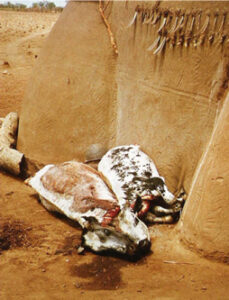
Killed cattle in Atekoba Yeri, 1973
Funeral at Atekoba Yeri, Sandema-Choabisa (fn 73,63): On the third day (19 April 1973) at 9.30 a.m., a cow and a bull were slaughtered with a special knife made by the blacksmith. These cattle were intended to produce new cattle for the deceased in the afterlife. However, these cattle were also for three men from Choabisa who had previously died with no cows having been sacrificed at their funeral celebrations. Their sacrifices made it ‘so they can’t complain’. Meat was cut from the breasts and hind legs of the cattle and given to the elders in the kusung, where it was distributed according to seniority. The elders sent the meat to their compounds, and the tails were given to the elders of Yongsa and Nabonsa (?), as Bilinsa had already received the tail at the previous funeral. Bilinsa was able to receive a tail because Kalijiisa and Bilinsa are descendants of the same father, while Abilyeri could never get a tail. In the evening, meat was given to other relatives in the kusung (not seen). None of the wives of the deceased were allowed to eat the meat of the sacrificial animals – not even those whose husbands had died three years ago or less. The meat was distributed to the others.
Danlardy Leander (fn 94,86*): Widows are not allowed to eat from kpaglika and nang-foba animals because their husbands’ (ritual) dirt (daung; plural: dangta) sticks to the animals. Otherwise, anyone can eat kpaglika animals, but only gravediggers could eat nang-foba animals.
U. Blanc (2000: 148f): According to Blanc, the double bell (sinleng or sinlengleng) and a small cylinder drum (ginggaung diak) are struck when the kpaglika animals have been killed. Blanc’s book also contains (p. 149) musical notations for the rhythms played on the two instruments.
James Agalic, MA thesis (fn 88,4a): Kpaglika is carried out at the funeral of an old wealthy man; its meat (e.g., of cows) is shared among the ko-bisa.
Evans Atuick (2013: 39f): Kpaglika (literally ‘leaning against’ [the nang-foba]) …is the practice of killing an additional animal (kpaglika) or a number of animals (kpagluta) in addition to the nang-foba... in order to pacify other older ancestral spirits who were not given the same treatment during their final funeral rites. Thus, the kpaglika is only done in rare cases where an adult male who died and had the funeral rites performed long before the current funeral without receiving the [same] type of animal(s) and number.
For instance, if a man’s deceased father was not given a cow as nang-foba during his final funeral rites and if this man’s family is wealthy enough to kill a cow for his nang-foba, another cow must be killed for their deceased grandfather. Hence, according to Bulsa custom, he ought to be served or given anything before the younger one could be served or given his share of it. The kpagluk is usually deposited at or close to the main entrance (nang-siuk) [of] the compound and can be eaten by any person regardless of status (one does not need to be an undertaker or to have eaten vayaam to be able to eat the kpagluk/kpagluta).
Azognab (2020: 43): The climax of the kuub-Kumsa ritual (‘the dry funeral’ performance) is the rite of nangsa fobka …and sometimes, kpa(g)lika or kpa(g)luk (killing of extra animals during the funeral by smashing them for other family members with high ranks who did not have the privilege of that honour during their funerals)… No dry funeral performance can be done among the Bulsa people without nang-foba or nangsa fobka.
p. 44: In a certain sense, the deceased often acts as a messenger to the next world; he receives ‘messages’ of kpa(g)lika animals from his family to certain family members in kpilung (the land of the living dead).
4.2.2.2 Procession to the ancestral house (guuk) and the earth shrine (tanggbain)
Awuliimba’s funeral, Sandema-Kalijiisa-Anuryeri (fn 88,224a): War dancers, the imitator (in the war dance group), and other people from Awuliimba’s house moved to the neighbour’s house (guuk?) about 500 metres away. The group walked once around a small tanggbain and once around the tampoi. Before returning to Awuliimba’s house, the elders talked to the people in the kusung.
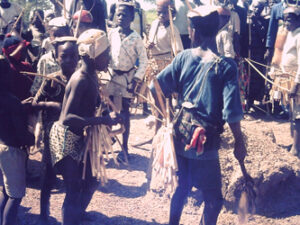
Children’s war dances at the ancestral home, 1973
Funeral at Atekoba Yeri, Sandema-Choabisa, after 2 p.m. (fn 73,64a): With war dancers and musicians, the entire crowd of visitors moved to the dilapidated ancestral house (guuk) in Choabisa. War dances, including those of the children’s war dance groups, were held there. The oldest ancestor’s bogluk– a large pile of stones under a tree – was greeted. Later, many of the group (with children and women) moved to the Alogta Tanggbain of Choabisa. My helpers (Godfrey Achaw and Augustine Akanbe) and I were not permitted to join them, although Thomas Achaab from Choabisa was. He said, ‘First, the tanggbain was greeted at the grove’s edge. Completely naked, the elders marched to the tanggbain, a pile of stones with a clay pot and a rope on the pile of stones. The women wore leaf clothing’. The group returned from the tanggbain at 3.15 p.m. When this occurs, and there is no offering, everyone may go into the grove fully clothed.
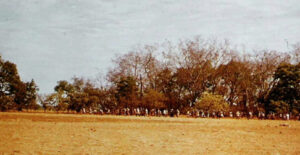
Procession from Atekoba Yeri to the Alogta Tanggbain, 1973
Danlardy Leander, 17 April 1996 (fn 94,86*): In Badomsa, people only go to the guuk at the funeral celebrations of significant men. The procession occurs on the first (kalika) or second day (tika dai) of the Kumsa at the Juka funeral on senlengsa dai. In Badomsa, no tanggbain is attended during funerals, but the teng-nyono is informed before the funeral begins.
4.2.2.3 Carrying mats out to a shade tree and back to the cattle yard
The meaning of this ritual could not be fully explained. In this regard, it is probably important to emphasise the kinship and emotional ties of the deceased married women to their parental home in another section.
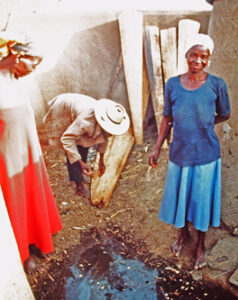
The mats in the cattle yard of Anyenangdu Yeri, 1991
Anyenangdu’s Kumsa, 4.40 p.m.: The rolled-up death mats (except Anyenangdu’s, which remained in the attic) were placed upside down in the corner of the cattle yard against the outer wall. The older women of the compound (Agbiera and Asiukpienlie) identified the mats so that they would be in the correct order. A gravedigger tore a piece of cord from each mat and gave it to the older (living) wives.
Funeral at Akadem Yeri, Wiaga-Yisobsa (fn 88,197a), 28 January 1989: Over a dozen dead people were included in the celebration. A pile of mats with busik baskets on top lay about 100 metres away from the compound. The mats of the compound’s deceased daughters, whose funerals had already been held in their husband’s section, were new and very thin. The women around the mats were singing. The mats, each carried by two women, were then moved towards the compound, but the procession stopped often. A mat came towards me, and a woman carrying it fell to the ground. I gave her 50 cedis, and the mat moved again. The mat of a married woman from Chiok went to her Chiok people, and only the wailing and singing of the Yisobsa people finally brought her to the cattle yard. When all the mats were there, the war dances could begin.
Funeral at Ataamkali Yeri, Wiaga-Longsa (fn 11,7a), 26 January 2011: Women carried the mats of the dead woman from the courtyard to under a shade tree. They sat down on benches and chairs around the mat. Leaning against the tree was a stirring stick and an obligatory calabash. This calabash (chin tuin) should always be near the mat and later contain water for the dead soul’s journey to the realm of the dead. Without it, the mat cannot move.

Mat with sinsan-guli women under a shade tree, Atamkaali Yeri, 2011
The men came dancing and singing to the mat four times, once with drums. The mat was brought back to the courtyard in the dark and then burnt in a field.
Funeral at Agbain Yeri, Wiaga-Yisobsa (fn 01,3a): When we arrived at 4 p.m., the sinsan-gula women, each holding a rattle, were already sitting around two death mats under a mango tree outside the compound. The men were sitting in an open kusung.
Between 4 and 6 p.m., a group of men sang to the sinsan-gula women and told them to prepare the mats to return to the compound. The women wound up the mats by winding several on top of each other. Two women each took a mat and set off dancing. Each mat wanted to arrive at its parent’s house, and one mat fell. Finally, all the mats arrived back at the cattle yard. A small grandson was rubbed with white ash. We left around 6 p.m., and speeches and the burning of the mats followed after our departure.
Funeral in Sichaasa, Wiaga (fn 88,185a), 19 January 1989: The funeral of an old man and an old woman occurred in the late afternoon. Two women surrounded by drummers carried the mat of the deceased woman, who wanted to return to her father’s house in Sandema-Abilyeri. The drummers held her back with their drumming, but the mat did not want to go back into the house yet and insisted on being carried around. When at last it was in the house, the war war dances began.
Danlardy Leander (fn 94,86*): Death mats are taken to the trees in front of the compound on the first day of the Kumsa.
U. Blanc (2000: 183ff.) Mats of the dead must be brought back to the cattle yard by the ko-lieba, where they bid farewell to the living. A ginggana drum group accompanies them (p. 187). Then, the last kum yiila songs are sung.
4.2.2.4 War dances (leelisa, sing. leelik)
Anyenangdu’s Kumsa, 4 March 1991, 5.30 p.m.: War dance groups from various sections appeared. After moving to Anyenangdu’s mat, the only one left at the granary (bui) in the cattle yard (see 4.2.2.3: Mats in the cattle yard), war dances started.
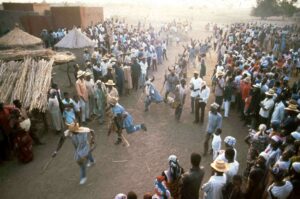
War dances in Anyenangdu Yeri, 1991
Awuliimba’s funeral, Sandema-Kalijiisa (fn 88,224a); 8 March 1989: War dance groups, including from Chariba, arrived after 11 a.m. A woman wiped off the warriors’ sweat.
Funeral at Akadem Yeri, Wiaga-Yisobsa (fn 88,197a), 6.15 p.m.: The gathering of the ‘warriors’ to perform the war dances took place. The war dances began when all the mats were back in the cattle yard.
Funeral at Ataamkali Yeri, Wiaga-Longsa (fn 11,7): The funeral celebration was held only for a married woman, so all war dances were cancelled.
Funeral at Atekoba Yeri, Sandema-Choabisa (fn 73,61b): From midday, delegations from the Tankunsa, Bilinsa, and Choabisa sections arrived with war dancers at different times. They went first to the cattle yard, where they greeted the mat. Then, war dances started, in which one war dancer had a live chicken and a hoe dangling from his body.

The children’s dance group from Atekoba Yeri, 1973
(fn 73,66b) Children formed a war dance group that was taken seriously and were thus allowed to visit the mat. Their helmets were simple calabashes with two small sticks as ‘horns’, and their war axes were ordinary sticks.
(fn 73,64a) On the third day (gbanta dai) at 2.00 p.m., war dances were performed again, but only the war dance group from Kalijiisa was present.
Godfrey Achaw (fn 73,49a): War dances begin inside the house, with the eldest [son?] leading them.
Danlardy Leander: All neighbouring sections are supposed to send war dance groups.
Yaw (fn 97,16b): The musical instruments used for war dances are: 1–2 dunduning (dunduning diak and dunduning chogsung) or two ginggaung drums (ginggaung diak and ginggaung chogsung). An hourglass drum (gunggong-diak) can only be added at secular festivals (e.g., the Fiok festival in Sandema) but never at funerals. Other accompanying instruments are two senlengsa double bells (diak and chogsung), one chang castanet, kantain horns, and tagalik flutes as a substitute for tapiliok flutes. Bells (logna) are attached to the quiver at will; their sound is produced only by movement. The kantain horn, which exists only in one size, is smaller than namuning. It is taboo to blow a kantain horn outside of a festival.
Margaret Arnheim (fn M10+29b): War dances are imitations of bulls. There are three dance figures: (1) slowly trotting forward, (2) quickly walking backwards, and (3) circling the trunk and looking backwards.
U. Blanc (2000: 87ff.): War dances (tugurik-yiila) are danced on the first two days and never on kpaata dai or gbanta dai. In Badomsa, the war dances begin in the evening after mats are prepared for burning. The war dance groups arrive during the day, first saluting the deceased’s mats and then dancing around the compound. The ginggaung (cylinder drum) is among these musical instruments and is always obligatory.
(p. 97): In Sandema, gurmansiak and tagalik are also played with war dances.
(p. 193–96): The warriors’ equipment [as well as] certain movements and gestures during the dance [signify] a kind of ‘secret language’ [with which] to communicate with each other (p. 193). Ideally, each section participating in the funeral should bring a war dance group. In reality, not all of them will have the appropriate instruments, dancers, or utensils. In principle, only men can be war dancers, but women sometimes join their rows without receiving the full status of war dancers (p. 194). Moreover, according to many older informants, war dances can only be performed for important personalities, but today, they are an integral part of every funeral celebration for the dead (p. 194).
See also F. Kröger in BULUK 11 (2018): ‘Cultural Heritage and Tourism: Bulsa Dances’, pp. 45–48.

War-dancers from Kalijiisa-Yongsa, 1973
4.2.2.5 Speeches (moolinka)
Anyenangdu’s Kumsa, 6.30 p.m.: Speech by Anamogsi (as the eldest son, compound head, or both) in front of the compound, followed by a speech by the ko-bisa (the heads of the three neighbouring compounds): Atinang, Ansoateng, and Atupoak. According to Danlardy Leander, at least the yeri-nyono and one kobiik must hold a speech in Badomsa.
Funeral at Atekoba Yeri, Sandema-Choabisa (fn 73,60): On 18 April 1973 at 3.45 p.m., a speech was held by the elder of Choabisa in a low voice, with another man responding by repeating the sentences at full volume. After each section, there was a pause for ululation by the women (wuuling or weeling). Two horn players on a flat roof gave signals and applause during these pauses.
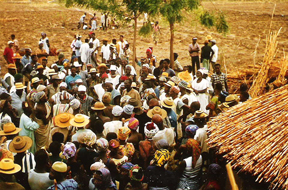
The elder’s speech in Choabisa, 1973
The content of the speech by the elder of Choabisa is reproduced in abridged form as follows:
(a) Welcome to all present and thanks to those who helped prepare for the festival.
b) At such an event, it is easy to harm someone through juju, but all should be warned not to do so at this funeral. All those present would be under the protection of the tanggbain. If anyone was harmed by juju, the tanggbain would kill the culprit within the next three days. If one of the participants died within this period of time, he or she would be considered a culprit. The speaker would sacrifice an ‘animal’ (dung) to the tanggbain in this case. [The elder did not name the type of animal – otherwise, the culprit could kill the same animal in front of the tanggbain at night and leave it there. In this case the tanggbain could not harm him. The evildoer must not sacrifice the animal; otherwise, he would die].
c) From now on, marriages can also be contracted within Kalijiisa – that is, between Choabisa and other Kalijiisa subsections [This had already been announced three years ago at a funeral celebration of another old man in Kalijiisa-Anyeri (Anuryeri?). There was only one such marriage in 1973].
d) All bachelors present are hoped to find a wife at this festival so that there will no longer be any at the next funeral.
e) All participants should get along well and love each other so that there will be rain and a good harvest.
Funeral in Sichaasa, Wiaga (F.K. paid a short visit on 19 January 1989): An old man delivered a speech, and a younger man responded. He also mentioned that someone had lost a pair of glasses last night and that the finder should hand them in.
Godfrey Achaw (fn 73.19a): The eldest son – responsible for his father’s funeral celebration – holds a speech on the first or the third day (at least in some parts of Bulsaland) of the Kumsa when gifts are given to friends (at the siinika?).
4.2.2.6 Bow, quiver and other weapons
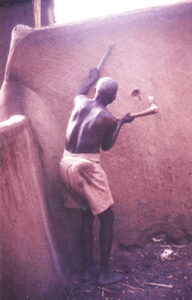
Aparimoak punches a hole in the outer wall, Anyenangdu Yeri, 1991
Anyenangdu’s Kumsa, 4 March 1991, 7.15 p.m.: Anamogsi took three of the dead man’s quivers to the elders in the kusung dok, who bid farewell to the dead man with a song.
(fn 94,22a): On the gbanta dai of the funeral, the logta nyinika ritual (literally, ‘coming out of the quiver’) occurred. The gravedigger, Aparimoak, knocked a hole in the outer compound wall (parik), in front of which a ram was killed. The arrows and bow (Martin Striewisch: also, the quiver) were passed through the hole three times to the outside before the gravediggers in the Juka celebration destroyed them. The hole was closed again (parik lika) on the last day (gbanta dai).
Anamogsi via Danlardy (fn 97,69*b), January 2000: The bow was only passed through the wall at the end of the Kumsa celebration and then immediately passed back again. Then, it was returned to the dalong, where it would remain until the Juka celebration.
Funeral at Atekoba Yeri, Sandema-Choabisa: At around 5 p.m., before the burning of the mats, the bow of the deceased was broken in front of the compound entrance.
Godfrey Achaw (fn 73,47b): Before the war dances, the eldest son must bend his father’s bow so hard that it breaks. As this is not so easy, it is first scratched with an axe.
Azognab (2020: 46), information from Afrafrarik Atnealim, Tankunsa (2018): During this ritual of the war dancing, at [after?] the third return from the grain store to the nansuing (the gate to the courtyard), the eldest son breaks the bow (tom) of his late father – or uncle, as the case may be – and wails.
Agbain Yeri, 2001
4.2.2.7 Nang-foba tabika (stepping on the dead nang-foba animals)
Anyenangdu’s funeral, 4 March 1991, 7.30 p.m.: In warrior costume, Anamogsi went to the tampoi and stepped on the nang-foba animals.

Nang-foba tabika in Agbain Yeri, 2001
Funeral at Agbain Yeri, Wiaga-Yisobsa (fn 01,3a): After 4 p.m. on the second day, two men danced to the tampoi, where two goats with bloated stomachs were lying. Later, a larger group came in only a little disguise.
Funeral in Sichaasa, Wiaga (fn 88,185a), 19 January 1989: Everyone moved to the tampoi where the dead animals (three sheep and three chickens) and the calabashes were lying. Three drummers (Abiisi, a man from Ayomo’s house, and another musician) played the same rhythm for 15 minutes. After about five firecrackers had been fired, the dancers appeared without any war dance costumes. The line of dancers, headed by a very old man, danced to the tampoi. The old man stepped on a dead sheep and left the group, after which the second (and third, fourth, and fifth?) did so. The rest danced once anti-clockwise around the compound; women with sticks also joined in. Three ginggana (cylinder drums) and wiisa (flutes) were played, but no horns and no hourglass drums were.
Danlardy Leander (fn 94,86*), 17 April 1996: In the nang-foba tabika ritual, the eldest son of the dead man always dances first, and he is also the first to place his foot on the dead animal…
4.2.2.8 Tiak Juka (mat burning)
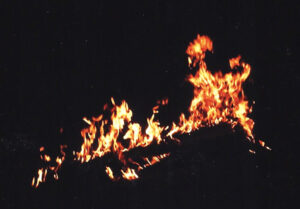
Burning of mats in Anyenangdu Yeri, 1991 (Dan)
Anyenangdu’s Kumsa, 7.30–8.00 p.m.: The mats were taken out to a field behind the tampoi. Anyenangdu’s mat was carried around the compound beforehand; then, all the mats were burnt together.
Funeral in Sichaasa, Wiaga (fn 88,185a), 19 January 1988: At around 6 p.m., the mat was carried out of the house and immediately set alight in a field, after which most people went home.
Awuliimba’s funeral, Sandema-Kalijiisa (fn 88,224a), 8 March 1989: Shortly before 6 p.m., the mat (two mats?) was (were) carried out of the cattle yard by two gravediggers. Women with sheep meat in animal skins, warriors, and many others followed. They paraded three times around the compound. Then, the two mats – previously rolled into each other – were set alight in the compound’s front field (doning). Awuliimba had died on one mat; the other, a new mat was added after his death. Awuliimba’s zu-kpaglik (neck support) was in one mat.
A man (Awuliimba’s eldest son or a gravedigger?) took children, about one year old, from their mothers and swung them three times through the fire. According to Apusik, these were biakaasung children (‘miscarriage children’). The ritual prevented them from being haunted by evil spirits (chicheri-baasa) via convulsions. According to Danlardy Leander (17 April 1996), this rite is unknown in Wiaga.
Funeral at Akadem Yeri, Wiaga-Yisobsa (fn 88,197a–b), 28 January 1989: The burning of the mats occurred at about 6.30 p.m.
Information from a neighbour: The mats were burnt west of the compound because the wind blew eastward. Burning them this way prevented the smell of the mats (piisim) from wafting back.
The fire destroys the piisim that clings to the mats from the dead person’s illness. Rich people also buy chemicals or perfume to ward against the odour and sprinkle it on the mats. Photographing the burning of the mats was permitted without issue after asking the elders in the kusung (they had permitted me to photograph everything except the women in leaf clothing).
Funeral at Atekoba Yeri, Sandema-Choabisa: At around 5 p.m., the shade roof in the cattle yard was torn down, and the mat was carried out. After breaking the bow in front of the main entrance to the compound (see above), two men moved around the compound with the mat – twice in the clockwise direction and a final, third time in the anti-clockwise direction. Then they went to a valley and halfway back again with the mat, where the mat was lit with no spectators. While the mat was burning, everyone moves to the compound. A man said that it was not right for me to film the mat ritual; later, a woman repeated this.
Funeral at Adiita Yeri, Wiaga-Yisobsa-Guuta: The second day was cancelled because there were only three days for deceased men. Therefore the mat was burnt on the first day. At 6.12 p.m., two gravediggers with bare upper bodies carried the mat (two mats?) to the cremation site. They carried the mat under their arms (in the beginning, the first man also carried it on his shoulder – never on his head). Blades of grass were placed around the mat and set alight (18:14). There were almost no spectators. There were no concerns about taking photos.
Funeral at Ataamkali Yeri, Wiaga-Longsa (fn 11,7a) 26 January 2011: The mat was carried out of the compound and burnt some distance away from the compound in the dark. The two mat-bearers told us we should have asked for permission to photograph beforehand.
Godfrey Achaw (fn 73,47b): Men and women parade around the compound singing. After the last procession, the death mat is carried by gravediggers. Children of the deceased throw money onto the mat, which other people pick up and keep. The mat, followed by people and drummers, is set alight at a valley. Back at the compound, a dance is organised at the tampoi.
R. Schott regarding Kalibisa: At 6.30 p.m., the mat is carried around the house and then burnt.
U. Blanc (2000:183f.): The ritual is usually performed shortly before sunset. Before, all the sleeping mats of the deceased people must have been set up in the cattle yard.
Aduedem (2019: 16): [On the evening of the first day,] towards [dusk], the widow is sent inside, and the gravediggers come to pick the mat for burning (juka). While they take the mat, the [lead] singer intones the funeral song the third time, and if the dead person was a yeri-nyono, all those he called his sons (bisa) perform a war dance (leelik) with the dead man’s logta [quivers] as the mat is being taken away. Moving a bit far from the house, the gravediggers remove the cloth that was kept inside and set the mat ablaze. It is forbidden for anyone to [contact] the heat of that fire. By burning the ta-pili, the soul of the deceased is released, but it does not enter the land of the dead…
4.2.3 Third day: kpaata dai or kpaam tue dai
Bean and millet dishes (each with a lot of shea butter) are prepared on the third day, and the remains of the meal are sacrificed to the compound wall on the fourth day (gbanta dai) (see 4.2.4.6 regarding parik kaabka).
The most detailed description and analysis of the kpaata dai can be found in the work of U. Blanc (2000: 197–207). Excerpts from her findings are summarised in abbreviated form below:
U. Blanc (2000: 197f): The food preparations often last the whole day. Sometimes, they go on into the night until the food can be distributed to relatives the next morning. The female members of the house where the funeral takes place provide beans and millet for the millet porridge (kpaata-saab). …The daughters-in-law of the deceased – the same women who perform the imitation (cherika) on the first and fourth day as cheri-lieba – are responsible for preparing the kpaam tue [beans with shea butter].
(p. 198): In the evening, the music is performed exclusively by the older musicians; until then, it was mainly children and young people who contributed to the entertainment. An ensemble from a ko-bisa section plays two calabash drums (gora), two flutes (wiisa) and two armpit drums (gunggona).
(p. 199): In the evening, the bean dish is distributed. First, the women and children, singers, other helpers, and children take their share; then, the women serve the food to the men waiting in front of the kusung dok [endnote 82]. Afterwards, the elders sing the kum yiila or the kpaam tue-yiila, at the beginning of which all meals must be finished; otherwise, the eaters are threatened with death [endnote 83]. The remains of the meal are buried.
(p. 200): Blanc describes the meal of kpaam tue as a ritual in which the deceased’s ancestors and souls also participate.
(p. 205): The women’s songs (kpaata yiila) are similar to those of the sinsan-gula women.
(p. 203): They can also air grievances or criticise the men in the kusung dok.
Funeral at Atekoba Yeri, Sandema-Choabisa (fn 73,65b) 1973: Dances and processions happened again in the morning. The bean and oil rites were not to occur until around midnight. I (F.K.) could not attend them because of a malaria case.
Funeral at Sichaasa (fn 88,185b), 21 January 2018: The oily beans were eaten in the evening between 8 and 9 p.m. They were also offered to guests (e.g., Danlardy). Otherwise, no important events happened during the day.
Funeral at Ataamkali Yeri, Wiaga-Longsa (fn 11.7b): Women prepared pito (see 4.2.3.1), shea butter (4.2.3.2), and the bean dish (4.2.3.3). The women cooked only for relatives-in-law of the compound but did not participate in eating the meal (?).
Aduedem (2019: 17): At [the dawning of kpaata dai], the sons send millet to the presiding woman’s (kuumu zuk kaldowa) compound. She receives the millet and dismisses them. Then, she goes to the bush, gets some leaves of shea nut trees (cham vaata) and mwanyak (a kind of grass), and brings them to the funeral house by the early hours of the day. [When she gets] close, she sits down on the way, maintaining a reasonable distance. Then, the sons who are preparing zo-nyiam go to meet her there. They will thank her and bring her to the back of the house (nan-gaang) with the items. There, she mixes the leaves and the grass in a clay pot containing water. The widow is led out to this location with other women, forming a wall [with their bodies] to hide her as she goes. Untwisted fibre (bok) or strings (miik), depending on the family or section of Buluk, are tied around her waist, chest, and head, [after which] she sits down. The untwisted fibre or strings identify the widow as such and emphasise her still-close connection to the dead spouse; therefore, they should not be removed until the widow’s remarriage. The presiding woman bathes [the widow] with the mixture [that was] prepared with the leaves and the mwanyak. Afterwards, zo-nyiam is prepared and given to the widow…[who] sips some of the zo-nyiam … and spits it [out towards] her left, front, and right. She [sips and spits] four times. Then, the presiding woman fetches some of the zom [powdered millet] into her palm … puts it in the widow’s mouth, and does as she did with the zo-nyiam [endnote 84]. Then, someone leads the widow inside again, where the presiding woman prepares another zo-nyiam for her; this time, [the widow] drinks the water and eats the zom if she likes. The [presiding] woman also prepares TZ with bogta soup and mudfish for the widow, [which she also] eats … if she wants.
E. Atuick (2020: 86): On the kpaata dai, the cheri-deiroa must be the first person to start the fire used for cooking the beans and the shea butter oil before other women can take over. She cracks the first shea nut before any other woman can help with cracking and pounding the nuts to process the oil.
The cheri-deiroa must also enter the ancestral room with the fire on a bunch of straws for the men to see and bind the louk [quiver] three times with a rope. Usually, an animal is killed to pacify the louk before tying it on the left, middle, and right parts… After this, they will carry the louk and the dead animal up to the roof top. While up there, they lift the animal and hold it upside down, together with the louk, make three loud cries, and drop it at the back of the compound. As soon as this is done, the men and the cheri-deiroa must jump after the animal over the wall to the back of the compound, where the men will skin the animal and give the cheri-deiroa the thigh of the animal as her share.
In the early hours of the day and when the kpaam tue is ready, the cheri-deiroa must be the first person to serve herself before anyone else can touch the food. When she is ready to serve herself, she enters the place where the food [has been placed in] a clay bowl and uses a ladle to fetch the food three or four times, depending on the sex of the deceased person she is impersonating…
At dawn, when the drums are played to herald the end of the eating of the kpaam tue, the cheri-deiroa, dressed as the deceased, goes to stand near the main entrance of the compound and makes a weliing [wuliing; plural: weliingsa or wuliingsa]: a prolonged, melodious, shrill cry [ululation]. [She does this] three or four times, depending on the sex of the deceased person [for whom the funeral is being performed]. While making the weliingsa, she will shout after each one so that the men in the kusung can hear [her message]: ‘I need a cow but not a sheep or goat’. Once the men hear the weliing and the demand for an animal, they know the cheri-deiroa is preparing to join them in the kusung (For further information, see Day 4, 4.2.4.1.).
4.2.3.1 Preparation of millet porridge and millet beer
Funeral at Ataamkali Yeri, Wiaga-Longsa, 28 January 2011 (fn 11,7b): Pito (daam) was prepared in the morning. At 4.30 p.m., the millet beer was ready.
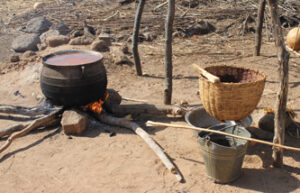
Brewing millet beer in Longsa, 2011
Anyenangdu’s Kumsa: Millet was pounded in the rock mortars to feed the visitors. Meanwhile, Agoalie was brewing pito for the next day (gbanta dai daam).
Margaret Arnheim, 1979: In her unpublished paper ‘Daam dika – The Brewing of Millet Beer’, Arnheim describes this preparation in full detail.
4.2.3.2 Shea butter production
A detailed report on the Bulsa production of shea butter can be found in Kröger 2001: 217–218.
Anyenangdu’s Kumsa (5 March 1991): In the evening, shea butter was made by Akumlie, Agbiera, and Achibilie in front of the kusung. They took two large chari bowls of roasted shea nuts to the mortar, where they were pounded and ground between two stones into a dark paste. The activity continued until nightfall.
Awuliimba’s funeral, Sandema-Kalijiisa (fn 88,225a), 9 March 1989: When I arrived at 6.30 p.m., almost no guests were present. In the north of the compound, three women were pounding the crushed shea nut kernels in a large mortar to a rhythm called kom manika: ‘xxx ‘xxx (3/4 time). Four working women can also beat this rhythm. The usual rhythm of a single woman is: ‘x ‘x ‘x.
At 7.00 p.m., grinding stones were taken to the kusung. Next to it, women dug a hole with a hoe and sprinkled coarse sand (tan-buusum) into the pit so that later, the fat could be separated more easily.
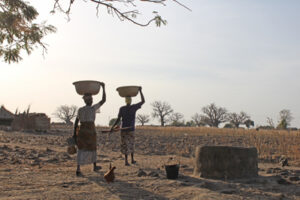
On the way to the nika-nika mill, Ataamkali Yeri, 2011
Funeral at Ataamkali Yeri, Wiaga-Longsa, 28 January 2011 (fn 11,7b): The house’s women went to the four neighbouring ko-bisa compounds to receive shea nuts, okro and dawa-dawa. Under the ‘mat tree’ of the previous day, two women heated up shea nuts in a large metal pot. Whereas in the past, the dark mass (kpaama) would have been grated between two stones, it was here transported in aluminium bowls to the motor-driven nika-nika mill.
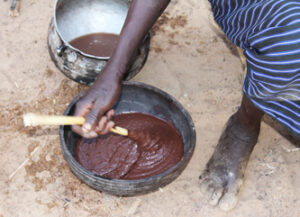
A small amount of shea butter is produced separately, Ataamkali Yeri, 2011
At the entrance to the compound, women (daughters-in-law?) pounded dark cooked shea butter on the grinding stones. While it was still very hot, the shea butter was stirred with a stick and later kneaded and beaten with the women’s hands.
4.2.3.3 Preparing beans (suma and tue)
Anyenangdu’s Kumsa (1991): After nightfall, while the shea nuts were still being ground outside, beans – both suma (round) and tue (small) – were cooked, and shea butter was added later.
The bean dish was distributed to the women (singers and helpers) in Agbiera’s courtyard, the elders in the kusung dok, and the general public (bimbaasa tue ne poi) in the kusung. (A hectic scramble ensued, and a lot of beans fell on the floor.)
Awuliimba’s funeral, Sandema-Kalijiisa (fn 88,225a), 9 March 1989: When I arrived after 6.30 p.m., the round beans (suma) were already cooking. No spices were to be added to this dish. When they were about half cooked, other beans (tue) – which have a shorter cooking time – were added. It is usually forbidden (kisi) to cook round beans and non-round beans together. The dish consisting of both types of beans is called kpaam tue.
Awuliimba’s funeral, 10 March 1989, information from Martin Striewisch: At 3.00 p.m., the bean dish was distributed in Awuliimba Yeri. Funeral songs began after the meal. Anyone who did not finish eating before the songs would die. Martin left at 5.00 a.m.
Ataamkali Yeri, Wiaga-Longsa (fn 11,7b), 28 January 2011: Small beans were cooked in a pot over the fire for the in-laws.
Aduedem (2019: 18): Women from the neighbourhood bring [foods such as] Bambara beans (suma), small beans (tue), shea nuts (jigsa), [and] saab-zom (flour for TZ) to the funeral house for the evening celebrations… Their preparations start straight away.
Apusik (fn 88,226b): The beans are also considered food for the dead.
Godfrey Achaw, Sandema-Kalijiisa (fn 73,48a): [Round and small beans] may not be eaten together in secular life. [This] food cooked by women with [much] oil is brought to the men at night. The men pounce [throw themselves at?] on it before the women give it to the men. After the meal, the men sing songs and go into the house three times (in the case of a dead man) or four times (in the case of a dead woman). When their song starts, the eating must stop. The remaining food must be thrown away and may not be eaten by anyone.
Danlardy Leander (17 April 1996): No salt or other spices may be added to the bean dish. Close relatives are called to the house between 2 and 3 p.m. to taste the bean dish. The oily beans are distributed to guests and eaten between 8 and 9 p.m.
Danlardy Leander 5 September 1996: Some of the beans are left in the cooking pot (usually a samoaning). These are sacrificed to the wall the following day (F.K.: This is a reversal of order, according to which supernatural beings receive food before the living).
Margaret Arnheim, Gbedema (fn M34b): No salt or pepper may be added to bean dishes. Margaret secretly added spices for herself.
Aduedem (2019: 18): see 4.2.3.2.
Azognab (2020: 47): [According to several informants,] on the third day (or the second day for funerals of ordinary men), which is the kpaata dai (‘shea butter day’), raw beans are prepared and served with shea butter in large quantities. These beans are termed kpaamtui [kpaam tue] (shea butter beans or oily beans) … Both the living and the dead share this meal as a symbol of their union and communion as a family and community.
The meal is normally ready after midnight, and it is assumed that the living dead [eat it] first; after that, the living can also partake of it… The deceased person must enjoy this for the last time in this life with the living relatives before going to the next world. But because he or she is now in the spirit form, he or she does not eat pepper or salt, so the beans should be prepared without salt and pepper. The beans will be served to the elders in the kusung first. The custom here is that the elders must ask for more shea butter on three occasions if it is a man’s funeral or on four occasions if it is a woman’s funeral. This is done through delegates from the nisoma (elders). Each time they ask for shea butter from the women in the courtyard, they must be given more. The meal is shared with the women in the dabiak (courtyard) and the men and children outside. Everyone, including [visitors], is allowed to take part in eating.
4.2.3.4 Preparation and consumption
Aduedem (2019: 18): By late evening, the Bambara [suma or round] beans and the [other] beans are set on fire in the same pot – which is forbidden in ordinary daily life – and [at] night, TZ [is also] prepared. When the varieties of the foods are done, say by late at night, the women serve [are served] first, then the deceased [and the deceased’s] sons (bisa) [are served] the kpaam tue (‘ oily beans’) – a mixture of Bambara beans and [other] beans with plenty of shea butter inside – [after which] the daughters [are served] and the food is distributed to everyone. The serving of the TZ also follows the same pattern. The kpaam tue ngobika (the eating of kpaam tue) continues till [near] dawn, [often] accompanied by the youth drumming and dancing in some cases. [Near the day’s] dawn, the women serve the kpaam tue in an earthenware bowl (kpalabik), put the oil in a chimbili (small calabash) for serving oil or sowing, and put it on top of the kpaam tue…[Along with] some TZ, they send [this] out to the kusung [endnote 85]. Two ‘courageous’ youth pour the oil into the kpaam tue and send the chimbili inside, saying: ‘kpaam ka, kpaam ka’, or ‘no oil, no oil’! The women inside will collect and give them oil; when they get out, they pour the oil out [before returning and repeating] the same procedure. When they do [this a] third time, they stop and eat everything [that has been] brought out [endnote 86].
4.2.3.5 Walking dances and singing
Anyenangdu’s Kumsa (1991): The elders sang bean songs (kpaam tue yiila) during their procession to the dead man’s granary and once around the compound.
Awuliimba’s funeral, Sandema-Kalijiisa-Anuryeri: Funeral songs began after the meal.
U. Blanc (2000: 16): The kpaam tue yiila of the men and sinsan-gula songs of the women (sinsan-gula: s. sinsan-guli) were sung.
(p. 17): Widows, who until now have lingered and lamented in their rooms, are escorted out, firmly supported by ko-lieba, and participate in the singing. There is no concluding ritual. The transition to the gbanta dai is seamless.
Aduedem (2019: 18): By cock-crow, when everything might have been eaten, those outside sing the kpaam tue yiili [endnote 87]. The women also come to the bui (barn) and sing their version of the kpaam tue yiili.
4.2.4 The fourth day: gbanta dai
The imitations (see the section on the first day, 4.2.1.15) – and, in some sections, the sinsan-gula chants (see first day, 4.2.1.14) – are continued on the fourth day, but the war dances usually are not.
U. Blanc (2000: 208–219): Musical activities at a man’s funeral are matters for the sons-in-law. In terms of musical practice, the day [gbanta dai] can be called the ‘day of affinal kinship’. At a woman’s funeral, her patrilineal relatives play the biggest role in its music. A distinction must be made between the sinsan-gula yiila of the wives of the funeral section and the kum yiila of the married daughters. Instrumental ensembles consist of groups of the funeral section, groups of the neighbouring sections, and groups of the sons-in-law.
4.2.4.1 Procession of sinsan-guli women and imitators to the kusung dok of the elders
Anyenangdu’s Kumsa: Anamogsi gave the sinsan-gula women a live sheep and money through the imitator of Anyenangdu (see the section on imitation, 4.2.1.15,). Other festival participants also gave money; these gifts were already part of the siinika ritual. The impersonator, accompanied by drums, went to the kusung dok to visit the elders.
Funeral at Asebkame Yeri, Wiaga-Chiok, fn 88,120b: In Chiok, unlike in Sinyangsa, sinsan-gula are no longer beaten on the gbanta dai.
U. Blanc (2000: 211): At dawn, a delegation of sinsan-gula women goes to the kusung of the elders to receive a live sheep or goat (a cheri-goat). A daughter-in-law still wears the clothes of the dead man. They make their demand three times (representing the male principle) or four times (representing the female principle). The head of the compound (Atengkadoa) thanks the sinsan-gula women for helping him remove the dirt (daung) from his house. He donates one bottle of akpeteshi, three bundles of millet, one live goat, and money. This concludes the sinsan-guli performances for the entire funeral celebration.
E. Atuick (2020) (continuation of the section regarding kpaata dai, 4.2.3.1): Once the men hear the weliing and the demand for an animal, they know the cheri-deiroa is preparing to join them in the kusung.
While this is happening, the women are singing dirges in the compound to lead the cheri-deiroa out to the kusung to join the men. Eventually, amid singing and dancing, she [the cheri-deiroa] exits the compound in the company of the chilie and other women to the kusung, where she sits while the chilie and her team exchange pleasantries with the men. The chilie, speaking on behalf of the cheri-deiroa, tells the men that their father or mother wants to go ‘home’ to the land of the dead and craves their indulgence before commencing the journey. Subsequently, the women resume the singing of dirges, and the men, moved by their singing and the presence of the deceased in the form of the cheri-deiroa, drop money on the cheri-deiroa and some of the singing women.
While the singing and dropping of money are going on, the men engage the cheri-deiroa in conversations they used to have with the deceased when he or she was with them. If the deceased is male, the cheri-deiroa automatically becomes a yeri-nyono [landlord, compound head] as soon as she enters the kusung. Hence, the ko-bisa must recount whatever issues were before them for decision-making and listen to the wise counsel of their ‘landlord’, the cheri-deiroa. She also has the licence to verbally and physically abuse anyone she knows the deceased did not like or see eye to eye with, including ordering people to get up and give her space to sit in the kusung.
4.2.4.2 Siinika (literally ‘piling up’): Distributing gifts
Today, the siinika ritual is sometimes performed on the first (kalika) or second (tika) day.
A secular siinika can also be organised outside of a funeral celebration. An example of this occurred at a graduation ceremony at Sandema Boarding School, as I experienced in 1973.
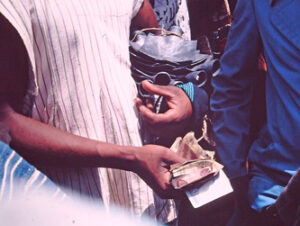
Hoe blades and banknotes as siinika gifts (Awuliimba), 1989
Awuliimba’s funeral, Sandema-Kalijiisa (fn 88,224b), 8 March 1989: The siinika was performed on the second day after the burning of the mat. Animals and hoes were distributed in the dark. James Agalic, Clement Agalic, Oldman, and others stood on the flat roof at the entrance. They threw the hoe blades as well as the dead, knotted sheep from there into the courtyard one by one [endnote 88].
One man complained that he had not been invited onto the roof to distribute the gifts. James Agalic apologised.
Cows were given out first: one to Yongsa, one to Kobdem, and one to Bilinsa. Then, sheep were given out (Barbara Meier wrote down the recipients): one for Prof Schott and his bisanga (B. Meier, M. Striewisch, F. Kröger, and others). The hoes were thrown down one by one. Due to the onset of darkness, further distribution was postponed to the gbanta day.
Anyenangdu’s Kumsa: From the flat roof, Adummoak announced who was to receive the gifts. Everyone could give money and hoe blades to their friends.
The following gifts, among others, were distributed:
From Anamogsi: 15 hoe blades and 1500 cedis.
From Atinang: 10 hoe blades and 1000 cedis.
From Anyik (Atinang’s son): five hoe blades and 500 cedis.
From Akabre (Atinang’s son): 10 hoe blades and 1000 cedis.
Two other men gave a few hoe blades and about 1000 cedis.
The sinsan-gula women and in-law relatives of Atinang, Anyik, Akabre, and Anamogsi were other important recipients.
Anamogsi and Atinang each gave a goat (Dan: one sheep each) for Anyenangdu’s imitation. Anyik and Ansoateng killed and skinned these animals, which were then cooked in front of the house by women from Anamogsi’s, Atinang’s, and Angoong’s compounds.
The siinika was completed around 10 a.m. (the next day), after which no more animals were given away.
Funeral at Abanarimi Yeri, Wiaga-Chiok (fn 88,233a), 16 March 1989: Gifts, such as hoe blades with 50-cedi notes, were distributed in the cattle yard. The sinsan-gula nyam (owners of rattles) received a goat.
Funeral at Adiita Yeri, Wiaga-Yisobsa-Guuta: The siinika was cancelled entirely.
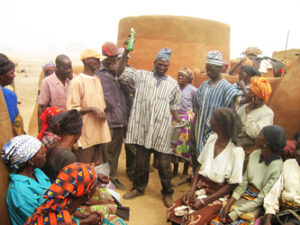
Siinika in Agaab Yeri, Chantiinsa, 2008
Funeral at Agaab Yeri, Wiaga-Yisobsa-Chantiinsa, starting at 9.42 a.m.: Two young men handed over presents to the recipients in the cattle yard (not from a roof), including two single bottles of akpeteshi, two single hoe blades, one coin, one banknote, and a bottle of akpeteshi with a banknote.
At 9.28 a.m., 10.10 a.m. and 11.23 a.m., the women in the cattle yard were served drinks.
Funeral at Atinang Yeri, Wiaga-Badomsa (not observed; information provided by Atefelik and Kojo from events on 9 March 2006): The siinika at Atinang’s funeral was, as usual, on the gbanta dai. The sinsan-gula women went (in protest?) from the cattle yard to a tree by the footpath. Other old women went to them and asked them to return to the cattle yard to be thanked. They gathered again at the granary (bui) and received an animal. The siinika also included drinks given to friends early in the morning.
Traditional siinika gifts are hoe blades and banknotes for friends.
Godfrey Achaw (fn 73,48a): From a flat roof or in front of the compound, relatives give gifts to friends of the house, especially hoe blades.
Leander Amoak (fn 79,1a): On the last funeral day, at 7 a.m., children and close relatives of the deceased climb onto the flat roof [at the entrance] and give gifts to friends of the deceased and to their own friends and girlfriends. Animals may only be given in killed form (contradicting other informants).
At his mother’s funeral, Leander gave one hoe and one dead goat with £3 (6 cedis) to Akabandoa, £2 and a hoe to his pok nong, Apaajaab, in Sichaasa of Akpewen-Yeri (Atigsidum, Leander’s wife, added £1), and £1 and one hoe blade to his second pok nong, Apoglik (his chief’s brother’s wife).
Gifts given by Leander’s first wife, Atigsidum: (1) £3 and two hoes (Adaaminyini added £1) to a man from Kadema whose wife is her best friend and who had also brought food for the funeral celebration, (2) £1 and one hoe to Awiag (her nong),.
Gifts given by Leander’s brother, Atiim: (1) one hoe and £2 to his pok nong (a close relative of his wife); (2) £2 and one hoe to his now deceased friend Akanyueta (Anueri Yeri),.
Many more gifts were also distributed. If the (pok-) nongta do not receive gifts, they are affected, easily threatening the relationship. Giving gifts publicly also publicises a friendship or relationship.
Danlardy Leander (fn 01,8): Siinika occurs not only at funeral celebrations but also at weddings, dances, and burials (e.g., at the burial of Danlardy’s stepmother, Maami Atigsidum). The gift of money that is pressed onto the forehead of musicians or dancers is also called siinika. You always give gifts to your friends. They do not need to be from the house of mourning, but they must be present [to receive them].
Danlardy (17 April 1996): Siinika is traditionally on the gbanta dai, but some organise it on the second day (tika). It must be preceded by the killing of kpaglika animals (usually very early in the morning). Siinika animals are always given away alive [F.K. The previous statement contradicts my observations, e.g., in Awuliimba Yeri, Sandema-Kalijiisa, where only dead animals were given away].
At Anyenangdu’s funeral, Danlardy gave Abawomba a hoe blade and money.
Yaw (fn 01,8b; FB 22–23): Siinika refers to the giving of gifts (money, millet flour, etc.) at a funeral celebration. The money a woman ties in her headscarf around her friend’s wrist is also called siinika (see 4.2.1.16).
At a funeral, residents give gifts to guests and vice versa. A siinika gift should be returned, but you can wait with it until you have a funeral in your own compound. If, for example, his wife Tenni is pregnant at Yaw’s father-in-law’s funeral, Yaw is not allowed to give gifts but can accept them.
Siinika also exists in chichambiri farm work. The organiser can give a new hoe blade (kunku-paali) to the eldest labourer and combine it with a gift that he should pass on to a certain other person. If he keeps it for himself, he can do so without being blamed, but he must inform the intended recipient. Other gifts are food, money, a straw hat, and even a girl as a future wife.
R. Schott: Sandema-Kalibisa: The siinika took place at 4 p.m. on the second day (tika) before the burning of the mat.
U. Blanc (2000: 210–12): At the kusung, the sinsan-gula women demand a sheep or a goat called the cheri-goat.
J. Agalic, MA thesis, p. 32, (fn 88,4a): As many sheep and goats as possible are given to close friends by the close relatives of the deceased. The recipients must ‘reciprocate’.
4.2.4.3 Unbloody killing of the sheep/goat by the sinsan-guli women (ngmetika = pinching)
According to Danlardy Leander and Atefelik from Sandema-Yongsa, this killing is not an independent ritual; rather, it is a part of the siinika ritual or a part of the cheri dungsa (as the killing was called in Akadem Yeri).
Anyenangdu’s Kumsa: Women tried to strangle the sheep (one stepped on its neck); Aparimoak killed it with a knife. The meat was distributed among the women, and a special payment was made for their night’s work on the third day (kpaata dai).
Awuliimba’s funeral, Sandema-Kalijiisa (fn 88,225b), 9 March 1989: In the cattle yard, two sheep were taken from the zong (cattle shed); women strangulated the first; the second was slaughtered as a gift for the women.
(fn 88,226a, Awuliimba): After killing and cutting up the first sheep, the meat was cooked, and millet porridge was prepared.
Funeral at Akadem Yeri, Wiaga-Yisobsa (fn 88,200b), 31 January 1989: A woman in the cattle yard tried to kill a goat lying on the ground without shedding blood. She kicked the goat on its neck until blood came out of its mouth and nose, but it got up again. A young man cut the goat’s neck with a knife and caught the blood in a calabash (?). In Buli, this killing of animals is called cheri dungsa or ngmeti dungsa (pinching the animals).
Funeral at Agaab Yeri, Wiaga-Yisobsa-Chantiinsa: The killing by strangulation was not seen. Photos were taken of the sheep and its cutting up.
Funeral at Adiita Yeri, Wiaga-Yisobsa-Guuta: The killing by strangulation was not seen. At 7.47 a.m., a dead sheep was lying in the cattle yard.
Funeral at Abanarimi Yeri, Wiaga-Chiok (fn 88,233a), 16 March 2018, after 9.30 am: The goat, which the sinsan-gula women had received at the siinika, was ‘symbolically’ strangled by a woman (a woman grabbed it by the neck) and then slaughtered by two men with a knife in the cattle yard. Its blood splashed into a calabash. The killing had to occur in the cattle yard due to this being related to women’s matters (see Video Film 5530ff.).
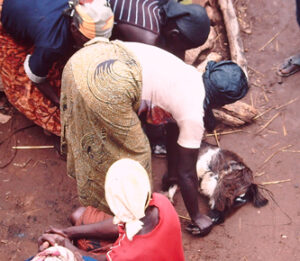
A woman attempting to strangle a goat in Abanarimi Yeri, Chiok, 1988
Ayomo Ayuali: The woman who also performed the cherika (imitation?), strangles the animals with her hands or steps on them.
U. Blanc (2000: 213): Distribution of the women’s goat or sheep: Pieces of meat from the neck, foreleg and stomach are taken out and roasted. The leader takes some of each piece, and the rest is distributed among the other women. Women in the ‘learning phase’ cannot eat anything from the animal.
E. Atuick (2020: 87): …the chilie will ask young men she trusts to kill and skin the animal to prepare the cheri saab.
4.2.4.4 Bath of the widows
Awuliimba’s funeral, Sandema-Kalijiisa (fn 88,225a+b), 9 March 1989: Exceptionally [because of the white visitors?], here in Kalijiisa, the ritual bath of the widows had already been performed in the early morning of the kpaata dai. On the gbanta dai, the widows wore leaves and three white, about two-centimetre-wide ribbons (pokogi or pokongta) woven from busum-boong around their foreheads, chests and hips [endnote 89]. The ribbons were ritually thrown away over the nang-gaang after the funeral celebration’s end.
Funeral at Agaab Yeri, Wiaga-Yisobsa-Chantiinsa: 10.27 a.m.: After the siinika, women in full dress moved through the cattle yard to the outer back portion of the compound. Some wore a headband, and some (one?) carried a staff (a millet stalk?). During the bath, they wore clothing made of leaves and were shielded by other women. Photos were strictly forbidden everywhere.
At noon, the widows marched in full dress to the kusung dok to say goodbye [to their late husband?]. Many wore black headscarves. One woman wore a calabash hat. According to unconfirmed information, this woman had already married another man. Some women entered the kusung dok, and others squatted at the entrance while sinsan-guli chants could still be heard. After this scene, many of the neighbours went home.
Observation after the bath: On the outer wall were the chari vessels and the leafy clothes from which they were washed. Branches were placed on top as protection, as touching the leaves is just like touching a widow: you have to marry her, or the widow marries a little boy by proxy. The leaves should remain in the widow’s room until the Juka, but as they decay quickly, only a few are taken; the others are thrown away and replaced with fresh leaves for the Juka. The leaves were mostly taken from the shea butter tree, only rarely from the nim tree.
Funeral at Adiita Yeri, Wiaga-Guuta (fn 2008,15b): On the gbanta dai at 9.45, the widows moved from their courtyard behind the compound. Several wore light-coloured headbands or a millet stalk. Some carried nim leaves (for clothing) in their hands. At 9.45, an old woman followed with a small liik pot and water. At 10 a.m., the widows returned, one carrying the (empty?) liik pot on her head.
Godfrey Achaw (fn 73,4a): There are minor differences in the funeral celebrations within Kalijiisa. In Yongsa and others, widows are only bathed; in other lineages (diina), they are also beaten with thorn branches.
Danlardy Leander (fn 94,86b*): Danlardy’s statement that the widows are only bathed at the end of the Juka funeral celebration is refuted by his own observations (see above).
4.2.4.5 Cheri dungsa (‘killing animals’) or cheri-deka (cheri: ‘to shed [blood]’)
Cheri dungsa animals are killed with a knife in front of or behind the compound (not over any shrine). Nang-foba animals are slain or suffocated without shedding blood. The skin of these ritually killed animals (except for donkeys and dogs) must not be consumed.
Anyenangdu’s Kumsa: Four sheep and one goat were killed and divided up as follows:
One goat was given to Aparik-moak because he fetched cham-viok.
The sheep’s hind legs were given to the women.
Its necks and hips were given to ‘daughters’ who helped with the cooking.
Its forelegs were cut into pieces and given to ‘uncles’ (ngesingsa) who had helped.
Its heads and the other forelegs were cooked and distributed among the children of the house and others.
Funeral at Abanarimi Yeri, Wiaga-Chiok (fn 88,233a), 16 March 1988: At 11.30 a.m., two goats were killed behind the house (for two older, married deceased women); almost simultaneously, two guinea fowls were killed in front of the house. The guinea fowls were for a young deceased boy and for a woman who had returned to her parental home with a child. She was receiving the funeral of a boy here. The goats had to be chopped up by the eldest son. When they were divided up, Danlardy, as the nephew (his FMM comes from Chiok), was allowed to choose which part he wanted. He was entitled to a front leg but chose the neck. One hind leg with part of the liver and part of the intestines (lungs) was destined for the elders in the kusung dok. They could grill their meat, cook it, or take it home to their families. Two front legs were given to the boosuk juiroa; two ‘hips’ (waists: chiak) with jiu-kuk (the lowest part of backbone) were given to the men who cut up the animals. The shepherd boys who had herded the goats were given the intestines (nyueta), tails, spleen (pimpeluk), and testicles of the male goat, which they immediately roasted and ate. An embryo was found in the female goat, which was buried immediately. The rest of the meat and the two heads were divided into two piles (corresponding to the two married women).
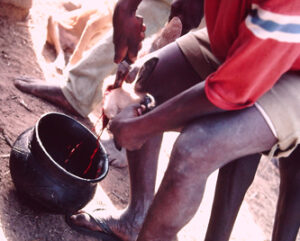
One of the two goats killed, Abanarimi Yeri, 1988

Cutting up and dividing the goats, Abanarimi Yeri, 1988
Funeral at Asebkame Yeri, Wiaga-Chiok (fn 88,119a), 6 December 1988: The funeral celebration was held for a man who died many years ago, a woman, and two children (with younger siblings at the time of their death). Thus, a large goat was killed at the entrance (not over a shrine) for the man, a smaller goat was killed for the woman behind the compound and one guinea fowl each was killed for each of the two deceased ‘children’ (childless women). The blood of the large goat fell into a bimbili pot, and its meat was immediately cut up on a straw mat with a knife (gebik) and an axe (liak) (see photos of Abanarimi Yeri). Meanwhile, the two chickens were killed and immediately plucked by children but were only later divided up and cooked by some men. A woman received a hind leg of the goat. Ako, the oldest blacksmith in the section, who was present at the time, received some entrails. The rest was needed for the afternoon meal.
Behind the house, the smaller goat was killed for the deceased woman and was immediately divided up. Its meat was cooked and later eaten with millet porridge. These killings were not sacrifices; they were offered in honour of the dead, and anyone could have killed the animals.
(fn 88,120a) Behind the house, women prepared millet porridge for the deceased woman. Women formed a human wall to protect their food from (ritually) stealing children (see 4.2.4.7, ‘snatching’). Atoalinpok’s older sister imitated the dead woman with a drum, but she only walked around the compound a short distance. The food was first distributed to the children, then to the men. They were called up according to sections of the sons-in-law (?). Finally, the doglieba and others also received their share.
Awuliimba’s funeral, Sandema-Kalijiisa (fn 88,225b), 9 March 1989: A sheep was killed by cutting its neck at the entrance to the compound. The loeluk (throat) was immediately cut from the neck and placed in the pot of blood. Two men cut up the sheep.
Funeral at Akadem Yeri, Wiaga-Yisobsa (fn 88,200a+b), 31 January 1989: Before 8.30 a.m. (when I arrived), several animals (goats, chickens, etc.) were killed and divided up at the front entrance for the deceased men, and behind the house for the deceased women.
Funeral at Adiita Yeri, Wiaga-Yisobsa-Guuta, 7.47 a.m.: One sheep (?) was killed.
Funeral at Agaab Yeri, Wiaga-Yisobsa-Chantiinsa, 10.39 a.m.: The blood of the first slaughtered goat flowed into a cheng pot, and its head was cut off completely. Together, about 6 (7?) goats were killed for the two men (near the entrance to the compound) and five women (about 20 metres away). They were gutted on a layer of millet stalks, cut up, and held over an open fire to burn off their fur.
Funeral at Atinang Yeri, Wiaga-Badomsa (fn 06,10): Cheri animals: Atinang received a posuk (sheep); Angmarisi (Atinang’s brother) received a buuk (goat); Kweku, Awonbiisi, Akansang, Agoalie, and Adiki received a goat each (the last four persons were from Anyenangdu Yeri).
Funeral at Agbain Yeri, Wiaga-Yisobsa (fn 01,3a): On 16 February 2001 and on 15 February 2001 (the gbanta dai), two goats were slaughtered at a front entrance (not the main entrance) at 9.50 a.m. They were then dissected on a layer of guinea-corn stalks by four boys. Their meat was destined for the cheri-lieba (the daughters of the house). These cooked it themselves, as well as the millet porridge, and then sacrificed it to the compound wall (see parik kaabka).
Funeral at Acha Yeri, Sandema-Chariba (fn 88,222a); 5 March 1989, gbanta dai: When I arrived at 10 a.m., the animals had already been killed.
Danlardy Leander (fn 94,86*): Cheri saab is prepared on gbanta dai using millet given by the dead person’s son’s relatives and neighbours. Anyone can eat it.
Aduedem (2019: 19): [At dawn] on this day [gbanta dai] [endnote 90], when the elders would have come and [sat] in the kusung dok, the daughter-in-law of the deceased [dressed] up in the deceased’s clothes, [came] to the main entrance (nan suung) and cried out [thrice saying] ‘maa yaa ka naab’: ‘I want a cow, I want a cow, I want a cow’. By daybreak, the sons [gave] an animal to the elders so that it [could] be given to the deceased. The daughter-in-law [brought] a pot to the parik, the animal [was] killed, and the blood [was] collected in the pot. It [was] skinned right there, and a forelimb and the waist [were] given to the daughter-in-law. TZ [was] prepared on that spot with the rest of the meat, … the cheri saab. The sons [were] served the saab first, then the daughters and everyone else [could] eat. The animal’s chest plus a leg, water, and TZ [were] served to the elders in the kusung dok. Then, as usual, the rest of the TZ [was] distributed, snatched, and eaten.
E. Atuick (2020: 87) [cheri saab]: Saab is the staple food of the Bulsa and is usually eaten with various vegetable soups, but during [funerals], the soup is prepared with dry okra or powdered peanut with animal meat. The cheri saab is usually ready by 2 or 3 p.m., when all lineage members gather for the grand funeral celebration.
The cheri-deiroa must be the first person to serve herself the food before others can be served. She starts by making the weliing cry three times if the deceased was a man or four times if the deceased was a woman before fetching some of the food into a bowl to eat before others can be served. After she has finished eating, she picks up the food-stirring stick (sapiri) with remnants of saab on it and smears oil on it while the chilie and other women distribute the rest of the food to people in order of seniority, starting with the kobiik in charge of the funeral, [finishing with] the children. While the sharing is ongoing, young men or children will come and snatch the boiled head of the animal and run away with it as part of the normal meal-related jesting they used to do with their deceased parent (After distributing and eating the food, the wall sacrifice will take place, see 4.2.4.6).
4.2.4.6 Parika kaabka (= cheri kaabka?): Sacrifice to the compound wall by women
As on other occasions, the west side of the compound (which has the main entrance, nansiung, and the forecourt, pielim) is considered the men’s side, while the areas behind the compound (nangaang, east) are the women’s side. Therefore, the offerings on the west side as described here are made to deceased men, while those on the east are made to deceased women.
In Wiaga-Guuta, I experienced that the men also offered a sacrifice to the wall with a chicken at a later time. Aduedem also mentions this sacrifice by men (see below).
Anyenangdu’s Kumsa, after noon (1991): The main actors were Ayoglie (Abapik Yeri), Asiukpienlie (Anyenangdu Yeri), Apoktiak (Atinang Yeri) and ‘daughters’ from Anyenangdu Yeri, Atinang Yeri, and Angoong Yeri. At the main entrance (nansiung), Ayoglie and Asiukpienlie smeared the bean dish (Dan: kpaan-tue: tue-sobluk, suma, and oil) on the wall. Ayoglie walked around the building with the ginggaung drum.
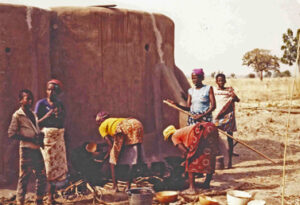
Women behind Abanarimi Yeri, 1988
Funeral at Abanarimi Yeri, Wiaga-Chiok (fn 88,233a), 16 March 1988; 2.10 p.m.: TZ was cooked at the entrance, while meat was cooked at the nangaang. There, a woman with a cylinder drum ran twice to the left, then twice to the right and back again (an act that indicated running around the compound). After the first run, a woman took millet porridge from the stirring stick and placed it in the two open hands of the woman performing the ‘sacrifice’. She smeared the porridge with both hands on the wall from bottom to top. Another woman covered the sacrificer’s eyes. This was repeated several times. Each time, a piece of millet porridge was thrown into the hearth fire.
Funeral at Asebkame Yeri, Wiaga-Chiok (fn 88,119b): After 1 p.m., millet porridge was prepared by women at the entrance to the compound. A young woman imitating the dead man ran around the compound three times with a drum to the laughter of those present. The millet porridge was ready, and the women stood in a circle around the cooking pot. They took small portions from the large pot several times and handed them to a woman who placed them in a smaller clay pot. The women ate first.
While the men sat in kusung, the women continued to determine all actions.
At 2 p.m. (?), everyone moved behind the compound, where the millet porridge was prepared for the deceased wife. Before the porridge was served, Afulanpok’s older sister from Guuta imitated (?) the dead with a drum. She was to run around the house four times, but she only did it once, and before running back and forth, she ran back and forth three times. The woman with the stirring stick also ran along some distance. Another woman with covered eyes smeared the bean dish on the wall (Video 3820). The millet porridge was first distributed to the children, then to the men. For the sons-in-law, the porridge was divided into pots according to their sections, which were called out. Finally, the doglieba and other guests also received their meal.
Awuliimba’s funeral, Sandema-Kalijiisa (fn 88,226a), 10 March 1989: Meat was cooked and prepared with millet porridge. A woman kneaded the porridge on a stirring stick and then smeared the beans, mixed with the millet porridge, on a corner of the entrance. After the imitator had run around the house with the drum, food was smeared on the wall again. During the third run, the woman only ran 50 metres to the left and back as a suggestion of a run around the compound. The smearing is called kaabka (sacrificing).
Funeral at Akadem Yeri, Wiaga-Yisobsa (fn 88,200a+b), 31 January 1989: Women cooked millet porridge at the entrance and at the nang-gaang (behind the compound) and distributed the food into bowls. In front of the compound, a woman kneaded a layer of millet porridge with hot oil on a sapiri stirring stick to keep soft. The drummer joined her and ran twice (?) to the right and back again, then thrice (?) around the house. Other women ran with her (including the woman with the millet porridge stick?). Millet water was poured onto the wall by a woman whose eyes were covered. Then, another young woman’s eyes were covered, and she rubbed TZ from the stirring stick on the wall of the house to the right side of a zamon-guni (entrance pillar). The beans from the previous day were also rubbed from bottom to top in the same place three times.
(see also 4.2.4.7 Snatching in Akadem Yeri).
Funeral at Acha Yeri, Sandema-Chariba: Millet porridge was kept soft on a stirring stick behind the house of mourning. Various ritual acts happened exactly as described in Wiaga, such as the smearing of the walls, the children’s grabbing for meat, and a woman walking around the compound with a large cylindrical drum.
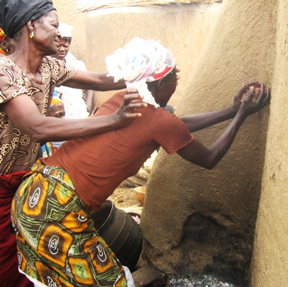
Parik kaabka in Agaab Yeri, 2008
Funeral at Agaab Yeri, Wiaga-Yisobsa-Chantiinsa: At 12.57 p.m., a temporary three-stone hearth was set up at the entrance to the compound. Women cooked the meat of the cheri dungsa there. TZ and beans were brought out from inside the house (leftovers from the kpaata dai).
1.30 p.m.: The meat for the dead men was taken onto a flat roof in the compound, and the meat for the women onto the flat roof of the house where the widows stayed.
2.35 p.m.: A woman spread TZ on the stirring stick and kneaded it continuously; another woman walked with a cylinder drum only a short distance to the entrance and back.
2.40 p.m.: A woman took millet porridge into her hand and added cooked beans. While another woman was covering her eyes, she spread the food in a corner from bottom to top of the wall (as if plastering walls). From 2.43 p.m., a similar sacrifice was made on the woman’s side (east).
2.51 p.m.: A liquid (clear water?) was poured over the sacrificial spot, after which the woman washed her hands and cleaned the stirring stick.
Funeral at Adiita Yeri, Wiaga-Yisobsa-Guuta: In the morning, the women showed the men in the kusung dok the meat for the wall sacrifice and a large calabash of millet for making the millet porridge. Food preparation began at 10.30 a.m. The finished millet porridge was poured into many clay bowls. After 10.52 a.m., a woman began kneading millet porridge on a stirring stick. At 11.02, a woman went to the entrance and back once with the stirring stick.
At 11.03 a.m., the sacrifice occurred as in Chantiinsa. However, the woman smeared the bean dish separately on the same spot on the wall in a second and third procedure. Then, she washed her hands and the stirring stick.
At 12.18 p.m., a man wearing a shirt sacrificed a chicken on the spot where the woman had sacrificed to the wall. He said a prayer and pressed the chicken’s feathers onto the sacrificial site; however, there was no chicken oracle of the dying chicken. Water (or some other liquid) was poured onto the sacrificial spot. The sacrificer drank from this first.
As the funeral was only held for two men, no sacrifices were made behind the compound.
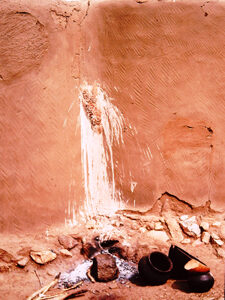
Sacrificial site (parik kaabka) in Agbain Yeri, 2001
Funeral at Agbain Yeri, Wiaga-Yisobsa (fn 01,3b): The cheri-lieba sacrificed millet porridge and meat that they had prepared. They ensured that no detail of the action was left out; otherwise, another goat would have to be slaughtered. They placed the (one?) goat’s head on a cheng vessel. Immediately after the sacrifice, a man could ‘snatch’ (chiagi) the head. ‘The opinions of my informants differed about the distribution of the other goat meat; however, the distribution of funeral meat differs from the normal distribution of meat.
Yaw (fn 08,17a): Women use the verb taari (to plaster) [to refer to their] offering to the wall, [while] men use the word kaabi (to sacrifice), and even the word bogluk (shrine) for the wall.
Danlardy Leander (fn 94,86*): The last recipients of the bean sacrifice are the ancestors, not the wall. The beans are always prepared on the kpaata dai. People are allowed to eat them before the sacrifice.
Danlardy (17.4.96): Sauce and millet porridge are not sacrificed (F.K., this contradicts my observations). Walking with the drum is part of the cheri kaabka ritual. The food is prepared from millet donated by relatives, for the deceased and neighbours .
Leander Amoak (fn 73,334a): The rites are performed at the zamon-guuna entrance pillar because these are also ‘storage barns’. They always sacrifice to the left pillar.
Godfrey Achaw (fn 73,47b): Women sacrifice goat meat and soup on the outer wall of the room where the dead person died [F.K.: this probably does not apply when observing these rituals for the male dead]. The goat must have been prepared outside the compound before nightfall.
U. Blanc (2000: 215f.): Daughters [F.K. daughters-in-law?] of the dead smear the bean dish, millet water (zom), and millet porridge on the outer compound wall near the entrance. One possible interpretation of this ritual is the symbolic repair of the building. Before the sacrifice, a woman (the imitator) walks around the compound with a cylinder drum.
Aduedem (2019: 19): … the rest of the [cheri saab] TZ is distributed, snatched, and eaten. When the cheri saab is over, a woman uses part of it to smear the parik or nang-gaang (if it is a woman’s funeral) like it was done to the kpaam tue.
(p. 21): After that [the gbanta], the sons or relatives bring a fowl (a small one this time) to the elders, and they give it to the ko-bisa. They take it and go to the parik – the wall joining the main entrance – and slaughter it, use the blood to smear the wall, and then throw it into the ashes where the cheri saab was prepared. Children pick it up [F.K. snatch it?] and roast it; technically, this funeral stage is now over.
Azognab (2020: 49) (his informant was Atombil Andoagelik, Sandema, 2018): Throwing the cheri saab (millet porridge) prepared with [meat from a] goat or sheep and soup for sacrificing [to] one of the front or back walls of the house… is done by the funeral personnel – usually women or sometimes men. The rest of the meal is shared among the family members.
E. Atuick (2020: 74), regarding what is done after cheri saab: After serving the women, the ko-biik in charge of the funeral, the ko-bisa in the kusung, and the children of the deceased, the chilie takes the liver of the animal, adds it to the remnants of saab scraped off from the sapiri and the leftover kpaam tue from the dawn’s activities, and performs the cheri sacrifice on the left wall of the main entrance to the compound if the deceased was a man or on the wall with drainage at the back of the compound if the deceased was a woman. [The chilie’s] eyes are usually closed while she is smearing the mixture of liver, saab, and beans on the wall [and] saying, ‘When you go, tell them nobody is left. Take this sacrifice and know that there is nobody again.’ She is praying against further painful deaths in the same compound to which the deceased belonged [F.K.: This probably means that the ancestors cannot call another person of the compound, as there are no more left]
What is intriguing about this sacrifice performed by the chilie is that the performance of sacrifices in Bulsa compounds is the [domain] of men, but on this occasion, [a woman performs it] while men only watch everything. By saying [the preceding line],. [By contrast,] led by the ko-biik in charge of the funeral performance, [the men] … sacrifice [the] fowls on the same wall after the women are done … allowing the blood and some feathers of the fowl[s] to remain on the wall, [as with] the items used by the women for their sacrifice.
4.2.4.7 Snatching (chiaka; infinitive: chiagi)
This staged, institutionalised theft by children (sometimes older people, as well) occurs before and during the sacrifice to the compound wall (parik kaabka).
Compare this to the distribution of prepared food at the Juka celebration in Wiaga-Mutuensa (fn 88,272a) (where some recipients took the meat from other dishes) and the licentious behaviour of the deceased’s grandchildren among the Koma (Kröger 2010: 364–367).
Funeral at Asebkame Yeri, Wiaga-Chiok (fn 88,119b), 2 p.m. (?): While millet porridge was being prepared for the deceased wife, everyone moved behind the compound (see 4.6). Many children (only males?) stood ready. If they could snatch a piece of meat, they could take it without being punished, but the women formed a protective human wall around the cooking area.
Funeral at Adiita Yeri, Wiaga-Yisobsa-Guuta: Ritually authorised stealing (snatching) occurred at 9.19 a.m. when the woman guarding the food was distracted by her ringing mobile phone. The young thief fled with the piece of meat and fought with other boys over it, but it was probably divided up later. Other attempts were made later, during which a boy was seriously injured on the tin roof and had to be taken to hospital.

‘Snatching’ in Guuta. Some boys fight over the captured meat
Funeral at Agaab Yeri, Wiaga-Yisobsa-Chantiinsa (see 4.6): At 1.30 p.m., a successful ‘snatching’ (grabbing) by boys took place. Later, a woman beat a boy who tried to steal meat. The men in the kusung dok also tried to hide meat from the women.
Funeral at Akadem Yeri, Wiaga-Yisobsa (fn 88,200b), 31 January 1989: While millet porridge was being kneaded on the stirring stick behind the compound and millet water and beans were being sacrificed to the wall, a man mingled among the women, lifted the lid of the meat pot and disappeared with a piece of meat amid the women’s shouting and insults. Danlardy (my companion) could have done the same. We also saw little boys running away with a calabash or a clay pot of millet porridge (Video 1365).
Awuliimba’s funeral, Sandema-Kalijiisa (fn 226a): After killing and cutting up the first sheep, meat was cooked, and millet porridge was prepared. A man went to the elders and explained to them that there would be little meat this time because the children had ‘stolen’ everything. Awuliimba’s eldest son tried to intimidate the children with a big stick.
Funeral at Agbain Yeri, Wiaga-Yisobsa (fn 01,3b): The cheri-lieba sacrificed millet porridge and meat (see above) that they had prepared themselves before… They placed the goat’s head on a cheng vessel. Immediately after the sacrifice, a man could ‘snatch’ the head (chiagi).
Aduedem (2019: 25): …Then they give one bowl of TZ to the deceased’s siblings (if any), and after that, they ask all to snatch (chiagi) the rest of the food.
According to Aduedem’s informant, snatching in Sandema does not have the character of ritual theft.
Atuick (2020: 88): While the sharing is ongoing, young men or children will snatch the animal’s boiled head and run away with it as part of the normal joking they used to do with their deceased parent.
4.2.4.8 Gbanta (divination)
Anyenangdu’s Kumsa: At around 3 p.m., three men were sent to the diviner, Akai. On their return, they waited behind the house until they were greeted with millet water by the kusung dok-dema. They declared that the funeral celebration had been conducted correctly.
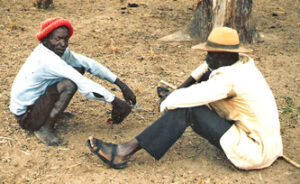
Divination at Abanarimi Yeri, Chiok, 1988
Funeral at Abanarimi Yeri, Wiaga-Chiok (fn 88,233a), 16 March 1988: Two men around 50 years old were appointed to perform the divination. The divination session took place under a nim tree. All the people passed by carelessly. As baan-doari, a stick was broken off the nim tree and the ground was cleaned, but no skin was underneath the divinatory procedure. Instead of two flat stones, only one quartz stone was there for the stick to hit. Both men held the stick, pointing upwards or circling above the ground. All of this took only a few minutes. Neither of the two men was a professional diviner. A woman had brought a busik basket full of millet to the diviners’ house (as a payment?). She came to them after the divinatory session with the empty basket.
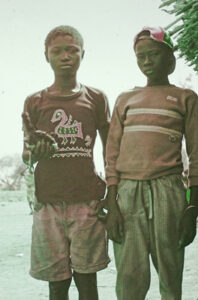
The two young diviners with the black chicken, Awuliimba Yeri, 1988
Awuliimba’s funeral, Sandema-Kalijiisa (fn 88,225b), 9 March 1989: A gravedigger instructed two boys around 12 years old to perform the divination. They sat in a corner near the northern outer wall of the compound and talked – without any indications of a divination session. After a few minutes, they returned to the kusung dok and received a small, dark chicken. They took it to the entrance of the compound, slit its throat, and ‘sacrificed’ it to the wall at the main entrance, where traces of millet porridge and the bean dish were still visible. They glued a few feathers to the compound wall, after which they were allowed to prepare the chicken for themselves.
Funeral at Akadem Yeri, Wiaga-Yisobsa (fn 88,200a+b), 31 January 1989: Three men (all yie-nyam, or heads of compounds) and I went to the diviner, Akannagayiri (Wabilinsa). They carried a white chicken and a basket full of millet panicles and cobs. On the way, some millet cobs fell from the basket and were not picked up again, as this falling was caused by the deceased or a ghost. The deceased (Akadem) had been very stingy during his lifetime and did not want the diviner to be paid too much. Shortly thereafter, a calabash of germinated millet fell to the ground and was immediately picked up.
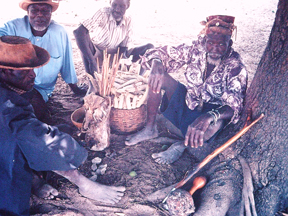
Deputies from Akadem Yeri and the diviner Akannagayiri
Akannagayiri, the diviner, was already sitting under a mango tree about 50 metres from his compound. He wore his red cap and a large horn on his chest. Two simple stones from the surrounding area were used as divinatory discs; these were chunks of cement that were almost completely crumbled after the session. He held only a very abbreviated session. Initially, some rattling and fiddling with the white chicken occurred. Then, he simply hit the two stones using the binary method. Although the divination bag was present, no symbolic objects were used. When the second yeri-nyono, an ex-serviceman who had just returned from the south, was offered to ask questions as a client, he said ‘N ze’ (‘I don’t know’), meaning he did not know the divinatory practices. The entire session lasted about ten minutes. Afterwards, they drank half a bottle of akpeteshi.
Funeral at Adiita Yeri, Wiaga-Yisobsa-Guuta: At 11.24 a.m., a young man entered the central granary and took out half a basket of millet. At 11.39 a.m., two young men with a chicken and a basket of za-monta (guinea corn) set off toward the dam. They settled down under a nim tree after a few hundred metres.
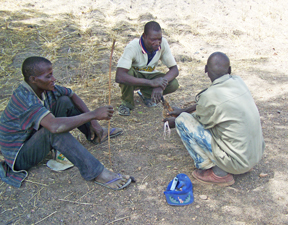
The ‘diviners’ of Adiita Yeri, 2008
There was no real divinatory session; the chicken was held on the ground for a few seconds and then killed by hitting it on the ground. It was immediately plucked and roasted on an open fire. The two men divided the chicken and the millet between them (I was also offered some meat). Beforehand, the outcome of the meeting had already been decided: another chicken had to be sacrificed to the wall by the men. One woman made a mistake by starting to prepare the chicken before the diviner’s result was announced. New millet water had to be prepared. Then, a man whose eyes were covered sacrificed a chicken to the wall. Only men whose father’s funeral celebration had already been held could eat its meat.
Funeral at Acha Yeri, information from Sandema-Chariba: In Sandema, people do not go to the diviner on the gbanta day, but two boys imitate diviners with a simple stick behind the compound. Then they return to the elders and receive a chicken, which they roast over the same fire on which the women cooked millet porridge. In Chuchuliga, the diviner comes to the compound of the deceased.
Alateng (teng-nyono of Kalijiisa): As the deceased woman in Acha Yeri had died of diarrhoea, the gbanta could not be performed until a new moon was born.
Akanming (diviner, Badomsa), information on the gbanta day (4 February 1989): The chicken does not necessarily have to be white. The diviner first holds it in his hand for a long time so that the jadok knows that the group has come for the funeral divination. The group brings two types of millet as well as kpaama (germinated millet), tabi (tobacco), and a chicken, which will later be sacrificed to the jadok. Pito will be brewed from a small amount of kpaama (malt), and porridge will be made from the millet. Everything will be sacrificed to the jadok in small amounts; nothing may be added.
U. Blanc (2000: 214f): Divination always occurs after the cheri dungsa of the evening. The answer to the question about the causes of death is usually ‘Naawen tuima’ (‘It was a work of God’). It is also asked whether everything was done properly at the funeral celebration.
Aduedem (2019: 21): Two young men are sent to go and sit behind the house. When they are gone, the TZ is sent to the tomb, and the gravediggers use it to sacrifice to the tomb (kaab buoosuk); the two young men [sat behind the house] are never supposed to see those going to the grave. When they return, the women enter [the house] while the gravediggers inform the elders they are back. The presiding woman brings [a] small [amount of] pito (gbanta daam) to the entrance of the kusung dok, and the two young men are called and questioned separately [about] where they went and what they got. One of them comes and answers that they went for divination (gbanta) [endnote 91] and he would mention the name of a diviner who is late (no more) as the person they went to. ‘Okay, what happened?’ the elders [then] ask, and the boy [responds] that the soothsaying indicated that the death was the work of God – ‘ka Wenni nyei’. They [then] give him the pito, [which] he spits out [to his] left, front, and right. He does [this] three times and is [then] allowed to go [F.K. This is probably a gaasika ritual]. The other youth [then] comes, [upon which] the same questions, answers, and pito-spitting are repeated.
Azognab (2020: 48) (his informant was Akaalie Aginteba in 2018): Actual divination (gbanta bokka) is performed on this day by a delegation that is dispatched by the elders in charge of the funeral to the house of the diviner to learn whether every ritual has been rightly performed and whether the ancestors (koba ale maba) are satisfied.
4.2.4.9 Da-tuek (bitter pito) [endnote 91a]
I (F.K.) have never knowingly seen rituals with the bitter pito and only have clear information about them from Robert Asekabta.
Robert Asekabta (August/September 2018 via Facebook Messenger): [The che-lie] also prepares the bitter pito (da-tuek). The malt is given to her on the first day of Kumsa. It is not boiled like ordinary pito [but] mixed in a small pot (cheng) [F.K. with cold water?]. Nothing is added. It is ready on the last day (gbanta). Nobody drinks it; it is even forbidden (ku a kisi kama). Some women go to the grave of the deceased with a drink (it is more or less for the deceased). Then, it is handed over to the old men in the kusung [dok], who will pour it away. [Until it has] been thrown away, the in-laws will not start [their] greeting.
The ritual of da-tuek is performed in the whole of Sandema, but I (Robert) do not know if it’s performed in the whole [of] Bulsaland. The bitter pito is not bitter in [terms of] taste but in a virtual (religious) sense.
Aduedem (2019: 131): Towards evening, TZ and pito (called gbanta daam, literally meaning ‘divination drink’) are prepared by the presiding woman in small quantities [F.K.: Is this the bitter pito?].
4.2.4.10 Visit of the sons-in-law (chichambisa) [endnote 92] and tying an animal to a stake (bob-zangi)
Anyenangdu Yeri (fn 01,3b): A group (‘sons-in-law’) from Anyenangdu Yeri prepared a visit for the gbanta of Azuma’s father’s funeral in Kubelinsa. Musicians arrived at 5 p.m., playing three ginggaung drums and six namunsa horns. They formed a circle before the compound and played while walking in it. Some older people in the kusung joined them. A group from the Restoration Power Chapel wearing white headscarves (symbolising joy) and black clothes appeared with their pastor (a brother of Robert Asekabta) because Azuma was a member of the church. A drum beat out a series of loud, single beats as a signal to leave. They left after 6 p.m. at dusk and returned at night while playing in a circle again (see above). Around 8 a.m., they gathered in the courtyard of Akumlie, Azuma’s mother-in-law.
According to Danlardy Leander, in addition to sons-in-law visiting the mourning compound, neighbours (ko-bisa) also appear, expecting gifts for their music.
Anyenangdu’s Kumsa: relatives-in-law (chichambisa) arrived after 4 p.m. As zaanga-dungsa, a sheep was donated by Bachinsa and a goat by Kubelinsa. In-law groups from Wiaga-Guuta, Wiaga-Longsa, Bachinsa, Kubelinsa, Sandema-Abilyeri, Sandema-Kori, Sandema-Tankunsa, Kanjaga, and Uwasi were also present.

Sons-in-law from Tankunsa are approaching Anyenangdu Yeri, 1991
Funeral at Abanarimi Yeri, Wiaga-Chiok (fn 88,233a), 16 March 1988: Groups of sons-in-law had already arrived before the parika kaabka ritual but were not permitted to greet the elders before the parika kaabka was over. Groups appeared from Zamsa, Siniensi, Wabilinsa and Kadema(at 4.40 p.m.). With each new arrival, four salutatory shots were fired.
Funeral at Asebkame Yeri, Wiaga-Chiok (fn 88,120a): At noon, a guest had already dug a hole in the ground directly before the entrance. The daughters of the house walked over it on their way to the mat. Later, their husbands (the sons-in-law) were to put money in it, which was intended as a gift to the children of the house. At 2.50 p.m., the sons-in-law arrived. Their wives, the daughters of the house, had been there since the first day. The sons-in-law also came to pick up their wives and bring them back home. If one was absent, the wife would stay at her parents’ compound until her husband arrived.
Other guests supported the wailing sons-in-law. In the group from Sichaasa, a grieving man always had to laugh while lamenting (Danlardy: This group is comprised of the sons-in-law’s friends, who only come for the food and the money for their music). The sons-in-law are given calabashes to symbolise the toil of digging a grave.
The groups only play ginggaung drums and namunsa.
Awuliimba’s funeral, Sandema-Kalijiisa-Anuryeri: After 9 p.m. on kpaata dai, members of Awuliimba’s wives’ sections (Wiaga, Balansa, Bilinmonsa) were sitting in the appropriate courtyards for these women. Sons of Awuliimba greeted them and, in one case, gave their guests a piece of tobacco.
(fn 88,226a), 10 March 1989, gbanta dai: Lamenting sons-in-law arrived and sat down in groups under shade trees (after which the socialising began).
Funeral at Akadem Yeri, Wiaga-Yisobsa (fn 88,200b), 31 January 1989: Sons-in-law arrived after the wall sacrifice. On our way home, we met many sons-in-law holding 3–5 hoe blades in their hands.
Funeral at Acha Yeri, Sandema-Chariba: A large delegation of sons-in-law appeared from Chana. The elders of Kalijiisa received them: First, they were simply welcomed; then, half an hour later, they were offered benches and finally greeted with speeches. Alateng, the earth-priest of Kalijiisa, gave the elder of the Chana section two small pieces of tobacco (for the pipe).
Funeral at Abapik Yeri, Wiaga-Badomsa, information by Danlardy Leander (88,305b): Sons-in-law received two calabashes of millet water and one basket of peanuts at Abapik Yeri.
Funeral at Atinang Yeri, Wiaga-Badomsa: Atinang’s funeral (fn 06,6a) was attended by his daughter, Asie, and her husband on the second day. Both mourned separately in front of the mat.
Bob-zangi (to tie to a pole)
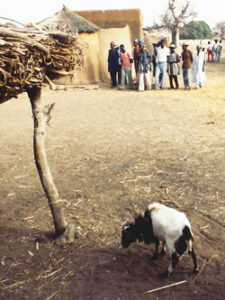
The sheep given by sons-in-law was tied to a pole (zangi), Anyenangdu Yeri, 1991
Leander Amoak (fn 81,24b): If a married woman’s father or mother has died, her husband must tie a goat or sheep to a stake (zangi) during the funeral celebration. Otherwise, in-laws can reclaim their daughter. The animal is always sold to cover the funeral expenses (nansiung sheep are always killed).
Yaw (fn 97,19b?) [In addition to] the sons-in-law of the actual mourning house [being obliged to] come with drums…those of the ko-bisa (in the compounds of Atuiri, Atinang, and Angoong) [must also do so]. The sons-in-law from Anyenangdu Yeri also went to Atinang Yeri with drums.
(fn 08.17a): Sons-in-law are not allowed to enter the house before the parik kaabka has been performed. They are not supposed to know the divination secrets. Therefore, they are assigned places at a certain distance from the compound.
Yaw (fn 01,2b): If a married woman in the house is pregnant, her relatives are not allowed to perform the bob-zanga ritual.
Danlardy Leander (fn 88,310b): Old and respected in-laws may be offered a cowhide,
U. Blanc (2000: 216ff): Sons-in-law are strictly obligated to present the organisers with hoe blades and a goat (a bob-zangi animal) ritually tied to a pole. Failure to do so can lead to divorce. Additional gifts can include liquor, kola nuts, and money. The singing sons-in-law are [typically] only accompanied by a ginggaung diak drum. Each group is given a place under a tree or in a free kusung. They are only allowed to [participate] after the parika kaabka. First, the sons-in-law greet the elders in the kusung dok and present their gifts. Then they march into the cattle yard, singing with the ginggaung diak.
Aduedem (2019: 20): … the sons-in-law come to perform the funeral (nye kumu), except when the son-in-law’s wife is pregnant. In that case, it is strictly forbidden. When a son-in-law is coming, he and his entourage (with their own set of ngan-nangta)… mourn by wailing or crying and then enter the house. The women among them enter the dabiak (courtyard) while the men, upon entering the nankpieng, return and sit under the nearest shade (not the kusung). Usually, the youth from the compound send logs for them to sit on. When they stop mourning, women from the house bring water to wash their faces. They wash and return the calabashes with money inside as a token of appreciation for the water.
Through their link man (san-yigmoa), they send word to the kusung dok [that] they want to greet. When they reach the kusung dok, they squat before the elders and greet them. Then, they give goora (cola nuts), taba (tobacco), three hoe blades, one ngoota kui for cold [the coldness they had to endure (endnote 93)], another [ngoota kui] for covering the ear [of a dead body] (turi lika kui), [a final ngoota kui] for covering the tomb (vorub lika kui) [endnote 94], drinks (mostly akpeteshi, but a crate of beer, too, is allowed), millet in a basin with smoked guinea fowl on top, and a goat or sheep ‘for the ‘tying of the pole’ (zangni bobka)’ [endnote 95]. These animals are usually sold after the funeral rites to defray some of the costs incurred by the family during the funeral rites [endnote 96], or they just ‘find a way of getting rid of them’ because it is strictly forbidden for the widow to eat anything from them: ‘she may not even step on their excreta’. Then, they enter the courtyard, greet the women and give them cola nuts, tobacco, drinks, money, etc. …the sons-in-law are encouraged to prepare food and drinks to refresh those that would come with him [them?] to help mourn his in-law.
Azognab (2020: 46; his informant was Aboro Atengkanya of Abilyeri in 2018): On the final day of the dry funeral celebration, when many visitors, especially the chichambisa (sons-in-law), troop in to console the bereaved family and offer drinks and money, it is the yeri-lieba or the che-lieba (as the case may be) who sit in the dalong (local hall) to respond to the greetings and receive the gifts.
4.2.4.11 Washing off the earth paint
Awuliimba’s funeral, Sandema-Kalijiisa (fn 88,225b), 9 March 1989: The daluk colour was not to be washed off until the gbanta dai; otherwise, sanctions would be imposed.
U. Blanc (2000: 219): While sons-in-law fulfil their obligations, relatives wash off the red laterite earth in the cattle yard as a final act. Then, the farewells begin.
4.2.4.12 Further gifts to participants and guests
Anyenangdu’s Kumsa: The in-laws from Bachinsa (Anamogsi’s first wife’s section) were entertained and received a sheep that was killed in Anyenangdu Yeri but not skinned there. Anamogsi justified this gift by saying he always had a good relationship with his first wife’s relatives.
Funeral at Abanarimi Yeri, Wiaga-Chiok-Ayaribisa: At 4.50 p.m., a busik full of za-monta and za-piela was brought to the kusung dok (the former smithy). One calabash full of this was for the rattle women. A woman brought a busik basket full of millet to her compound in the immediate neighbourhood.
Awuliimba’s funeral, Sandema-Kalijiisa-Anuryeri: Calabashes of sorghum and other millet types were brought to the kusung dok. It was a gift for the elders (Video 5082).
Danlardy Leander, September 1996 and January 1997 (letters): The wives of the sons of the deceased bring a mat or, if they cannot, a calabash as a gift. The mats are distributed among the che-lieba (imitators) at the gbanta dai. If some mats are left over, they are given to the daughters of the deceased.
4.2.4.13 Bow and quiver
(See the second day of the Kumsa funerals: 4.2.2.6): Bows, quivers, and other weapons.
Awuliimba’s funeral, Sandema-Kalijiisa-Anuryeri: The bow and quiver of the deceased are returned to the kpilima dok.
4.2.4.14 Food for the guests
Funeral at Abanarimi Yeri (Wiaga-Chiok-Ayaribisa): After 5.30 p.m., the meal and then the amusements (diinta) started.
Funerals at Agaab Yeri and Adiita Yeri, Wiaga: After 3 p.m., the meal began for the guests. In Guuta, a sheep was killed for this meal early in the morning. The fact that it was not a ritually killed ‘sacrifice’ was evident from the fact that its skin had been scraped off over an open fire. When I was also offered a hot meal in the afternoon, I was told that I could not refuse, as catering for guests was mandatory as ‘part of the ritual of a funeral celebration’.
4.2.4.15 Widow’s pobsika at the main entrance
Aduedem (2019: 22): The presiding woman of the funeral brings the widow to the main entrance, and she (the widow) blows some ashes towards the presiding woman (pomsi tuntuem/buntuem). When the tuntuem/buntuem pomsika is over, the widow can associate and move freely among the people until the Juka rites again, upon which she resumes her life of isolation. At this stage, the funeral is over.
4.2.4.16 Opening the grain store (bui)
Anyenangdu’s Kumsa (fn 94,87b; 97,51a; 9763b*): The central granary, which had been closed (bui lika) on the first day of the Kumsa funeral after the first song (yiili), was reopened again (bui laka) at the end of the fourth day (gbanta dai).
Danlardy (fn 01,22a): The upper opening of Anyenangdu Yeri’s granary had not been completely closed with clay balls.
ENDNOTES (Kumsa)
70 (Footnote in Azognab 2020) An interview with Aburinya Ayaakadin, funeral personnel, Siniensi on 5 May 2018.
71 (Footnote in Azognab 2020) An interview with Aburinya Ayaakadin, funeral personnel, Siniensi on 5 May 2018.
72 (Footnote in Azognab 2020) An interview with Anab Anankansa, funeral personnel in Abiliyeri, Sandema, 10 May 2018.
73 His eldest son may use other belongings of a deceased person (e.g., books, tools).
74 (Footnote in Azognab 2020) An interview with Akaalie Aginteba, a female funeral personnel in Sandema, April 2018.
75 (F.K.) In my observations and according to most of my informants, a puuk is a small ceramic-lidded vessel. Atuick’s later statement that the ‘puusa (pl.) … are… broken into pieces’ corroborates this.
76 (Footnote 49 in Aduedem 2019: 14) However, if it were a woman’s funeral, the mat would be sent outside the house and placed under a tree in the direction of her paternal home or village (ko yie suuk, literally meaning ‘the road to father’s compound’). F.K.: According to my observations, this placement happens later.
77 (Footnote 59, in Aduedem 2019: 14) This logta (quiver) will finally be burnt on the day before last in the next stage (of the kuub-juka). Moreover, the log and bow have no connection with the person being a hunter; they may be bought for the funeral rites
79 (Footnote 57, in Aduedem 2019: 16) This woman is basically in charge of the funeral rites as far as the women’s roles are concerned. Part of her role is to liaise between the elders and what happens inside and outside. She absolutely cannot come from the house where the funeral is being performed.
80 (Footnote 58, in Aduedem 2019: 16) She is not supposed to hear what is happening.
81 According to the lakori principle (see Kröger 2012), rites and other important actions should be performed in a present ritual exactly as in previous ones. If one does not want to adhere to this principle and introduce additional ritual elements, the omissions of past elements must be made up for in the present time, such as through further sacrifices, grave offerings, or rites.
82 This is again a reversal of behaviour practised outside the celebrations of the dead; usually, the men receive their hot food before the women and children.
83 (F.K.) Possibly, this prohibition refers already to the parik kaabka ritual of the following day, as before a sacrifice, no one is allowed to eat the sacrificial food.
84 This ritual is similar to the gaasika ritual, although Aduedem did not call it this.
85 Normally, in this night session, no elders (nisoma or ko-bisa) are present, so the youth will receive the food.
86 This eating is normally done after the children’s snatching (chiaka).
87 The song also indicates that the eating of kpaam tue or any other food is over for that night.
88 This observation contradicts Danlardy Leander’s statement that animals are only given away alive at the siinika.
89 Danlardy Amoak: In Wiaga, widows do not wear headbands (contradicted by my observations and other informants). Information from Akututera (Sandema-Kalijiisa): Wiaga women are just too lazy. The headband (bogta) is simply a peeled-off kazagsa strip with the white side facing outside. The waist cord (miik) consists of three braided kazagsa strips. For this, two strips are laid crosswise on top of each other, and all four ends are bent over. One end is cut off, and the other three are braided. During braiding, the single strands are twisted.
90 (Footnote 68, in Aduedem 2019: 19) Technically, just a few minutes after the kpaam tue ngobika had ended.
91 The ‘gbanta dai’ (the day of divination) got its overall name from this.
91a Among the LoDaaga of Northern Ghana, the term ‘bitter beer’ (Ko Dãã Tuo) refers to a part of the post-burial rites comprising (1) the bathing of the widow, (2) the creation of the provisional ancestor shrine, and (3) the settlement of the estate (Goody 1962: 220–234).
I cannot see any relation between this and the short Bulsa ritual described here.
92 (F.K.) Not all these visitors are direct sons-in-law of the deceased; men of their section may accompany them.
93 This hoe is intended for the elders in the kusung for having been there despite the cold.
94 During the burial, a hoe is used to cover the ear of the deceased to prevent soil from entering. This hoe, given by a son-in-law, replaces the hoe of the burial.
95 E. Atuick, ‘Are Final Funeral Rites in Buluk Really Expensive?’ BULUK 2013.
96 Ibid.